
































His main goal is to establish PSHS–MC as the flagship campus of the PSHSS.
He added, “by flagship campus, I mean that the other campuses should start looking up at us, that we should lead, and that we should serve as the model campus of the PSHSS.”
To achieve this, he wants to lower the scholarship rejection rate. This refers to the number of qualified applicants that do not accept the scholarship for PSHS-MC.
According to him, the scholarship rejection rate of PSHS–MC is one of the highest in the system, at around 50-60%. While he mentions that there are many reasons why someone would not take a scholarship to PSHS-MC, such as geographic proximity, there are also many that “simply tried the exams to see if they [could] pass it”.

years of his term.
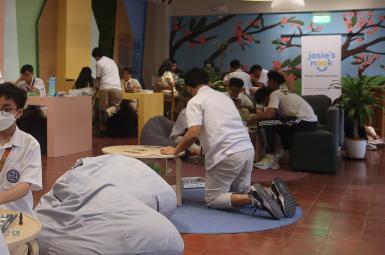
Bianca Liezl Espinoza
In support of student mental health, the Philippine Science High School—Main Campus (PSHS–MC) officially opened its Student Wellness Center last January 9.
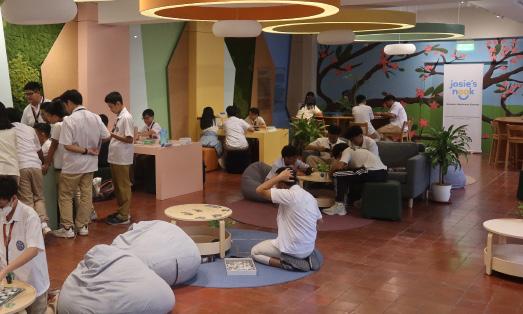
The center, located on the 2nd floor of the Science and Humanities Building (SHB), serves as a space for students to relax and recharge throughout school days. It houses various bean bags, couches, board games, and arts and crafts materials to encourage healthy coping strategies and reduce stress among students.
The room also features bright, calming colors and natural elements to evoke a comforting atmosphere. This initiative was led by the PSHS–MC Batch 1998 for their silver jubilee year’s legacy project. The alumni batch tapped numerous donors and sponsors, naming the center “Josie’s Nook” after Mrs. Josefina Yu, co-founder and matriarch of major sponsor Seaoil Philippines.

Present at the January 9 inauguration were Seaoil CEO Glenn Yu, Seaoil President (Commercial) and COO Stephen Yu, Seaoil President (Retail) and CFO Mark Yu, Palawan
Group of Companies President and CEO Karlo Castro, EChimes Pharmaceutical CEO Orlando Bautista, PSHS Main Campus Director Rod Allan De Lara, PSHS Foundation Chairman Reynaldo Vea, interior designer Maria Monica Clarino Tongol, architect Marvin Tongol, PSHS Batch ‘98 alumni, PSHS faculty and staff, PSHS Foundation board members and officers, as well as students and parents.
In an interview with GMA News, Seaoil President and CFO Mark Yu expressed their family’s commitment to empowering Philippine education and his hopes to transform PSHS–MC students’ educational journey through the center.
“I’m hoping that the memories for that room moving forward will now change to something where they look back, and they say, ‘this is where I really had the best time when I was in Pisay,”’ Yu stated.
“If we truly are the premier STEM school in the Philippines, people should choose [us].”
Siobe Saavedra
Additionally, he wants to lower the rate of scholars within PSHS-MC that do not finish the full six-year scholarship.
“Each of these students have already proven . . . by being in the top 240 that [they] have the intellect to pass the curriculum.”
With this, he pushes for better intervention programs, stating: “They have really proven that they belong to the top 0.01% of the nation. Siguro bumabagsak sila because wala yung intervention. So we really need to strengthen the intervention.”
He said that he wanted to give the students more non-academic outlets, such as physical activities and art, to truly achieve a holistic education.
To the community, Dr. De Lara expresses full commitment in view of his service, “What I can really just promise, at the end of my term, I will make sure that [PSHS-MC] will be in a much better place.”
‘Dream come true’: Olivia Rodrigo felt ‘so Filipina’ during GUTS concert in PH
Last October 5, FilipinoAmerican singer and award-winning artist Olivia Rodrigo embraced her heritage when she graced the Philippine Arena stage for the Manila leg of her GUTS World Tour.
Filipino fans’ anticipation for the renowned artist to perform in the country was palpable as they took to social media platforms to express their excitement, with many affectionately dubbing her pinsan (cousin) and congratulating her on her homecoming.
“It’s such an honor to be here tonight as it’s my first time in the Philippines! [...] I can’t tell you how special tonight is, and I’m so, so thankful that you’re here. Salamat po (Thank you),” Rodrigo announced to the crowd after her first two opening songs, “bad idea right?” and “ballad of a homes chooled girl.”
show, the singer led the audience through all of her songs on her most recent album, GUTS, with some performances of songs from her debut album SOUR.
high-energy pop-alternative ballads, she took to the piano and acoustic guitar for her more intimate songs, such as “teenage dream” and “happier.”
Rodrigo was delighted at the attendees’ energy throughout the whole concert, pointing out the palpable enthusiasm among the sea of purple and silver: “[You guys are] so loud and so gorgeous, [and] you guys are wearing such cute little outfits.”
The venue was sold out for her Silver Star Show, a Manila-special charity concert, with over 55,000 Filipino







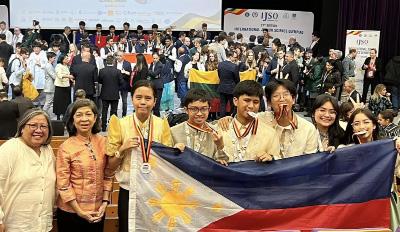
Corinne Llantero
Batch 2025 (B2025) students of the Philippine Science High School-Main Campus (PSHS–MC) recently marked a milestone by registering to vote. As now-eligible voters, this signifies their entry into the democratic process, with their first task being the 2025 Midterm Elections.
Historically, the youth (ages 18-40) have played a crucial role in elections. In the 2022 national election, COMELEC reported that over half of the registered voters were from the youth. Notably, Generation Z (ages 18-25) alone accounted for 20% of the total registered voters.
While this may vary with everyone, according to Bianca Espinoza of Batch 2025, her milestone was accompanied by a lengthy and tedious process that took about 3 hours to be completed. She believes that having the option to register online or by mail, instead of the traditional barangay registration, would result in a higher voter turnout. However, for some cases like Franco Kasilag of Batch 2025, his experience was rather easy. He stated, “It might’ve been luck as there weren’t many new voters from my area”, allowing him to finish after 20 minutes of filling up and scheduling.
In light of the approaching elections, voting, as Espinoza believes, is Kasilag also mentioned voting being important to an extent that it can be considered a civic duty.
Despite the exhausting and monotonous nature of voting, enduring endless debates, and spending hours in long lines, as Kasilag described, “The truth is, constantly fact-checking information, getting into heated political discussions online, and falling in line for hours to submit your ballot feels tiring and pointless. But they simply need to be done, and I look forward to having qualified and proper leaders as a payoff for those efforts.”

The Philippine Consulate General (PCG) in San Francisco and the Philippine Embassy in the United States (US) have both begun programs to assist Filipinos who would be affected by Donald Trump’s mass deportation policy.
The Philippine Embassy has launched a 24/7 hotline for Filipinos, while the San Francisco PCG held a hybrid learning forum titled “2025 Critical Updates in US Immigration Law” on January 23.
The Philippine Embassy also announced that they were searching for ways to provide free legal assistance to illegal Filipino immigrants in the US.
Immigration lawyer Lourdes Tancinco, who was the PCG forum’s keynote speaker, provided insights
on the policy changes under the Trump administration, especially in regards to immigration, and spoke about how consular offices can assist the Filipino community.
Meanwhile, Philippine Consul General to San Francisco Neil Frank Ferrer stated that, “The Philippine Consulate General stands ready to extend consular services and appropriate assistance to Filipinos across its jurisdiction, regardless of immigration status.”
These programs were established in the wake of Donald Trump’s announcement to stop “all illegal entry” and deport “millions and millions of criminal aliens” during his inaugural speech on Monday, January 20.
According to Philippine Ambassador to the United States Jose
Manuel Romualdez, there are roughly 250,000–350,000 illegal Filipino immigrants in the US.
He admitted that it was likely that illegal Filipino immigrants with criminal records or those who have not filed for documentation to make themselves legal in the US would be deported.
This was proven when 24 illegal Filipino immigrants were deported for minor crimes as the mass deportation policy took effect.
To the Filipino illegal immigrants, he advised that they leave the US voluntarily or seek advice from an immigration lawyer.
“The advice is simple, do what is correct because that is the only way you will have peace of mind,” Romualdez added.
rade 9 and 10 students from Philippine Science High School — Main Campus (PSHS—MC) took home six bronze medals in the 21st International Junior Science Olympiad (IJSO) in Bucharest, Romania.
The event was held from December 2 to 12, 2024, with more than 500 contestants from over 50 countries undergoing rigorous theoretical and practical tests in the natural sciences, including physics, chemistry, and biology.
Ellison Mathew Ang, Jacob Dizon, Anela Miu Fernandez, Sophia Ysabelle Landicho of Batch 2027, and Joseph Dominic Cruz of Batch 2026 secured bronze medals.
Ariana Zane Aparicio of Batch 2027 also contributed to the team’s score.
“The competition itself was very difficult with three rounds (multiple choice, problem solving, and practical), but made manageable by our preparations,” shared Landicho.
The students shared that around two months of studying and training were needed for the competition.
“I opened almost all the books Pisay had given to us…and read through [them] almost religiously,”
Bianca Liezl Espinoza
commented Dizon, who recounted the difficulty in managing time for the contest, along with school requirements, training sessions, and supplementary lessons.
However, for Landicho, the real preparation happened in Romania.
“My teammates and I would spend our time until early in the morning, going through past papers, reviewers, [and] notes,” Landicho said. “We were able to coach each other by teaching what we knew…as well as asking other teams about certain topics.”
When asked about their win, Dizon shared that the experience felt “magical.”
Meanwhile, for Ang, it was “a mix of shock and relief knowing that despite how competitive the field of participants were, we were able to win an award, and our hard work paid off.”
Similarly, Landicho shared: “It felt great that the hard work we put into preparing for the competition [paid] off and that we could bring pride to ourselves, our families, our school, and even the Philippines.”
The 22nd IJSO will be held next year in Russia.
The Commission on Elections
(COMELEC) released the official list of senatorial aspirants for the 2025 elections last October 16, 2024.
After the eight-day filing of certificates of candidacy last October 1 to 8, 2024 at the Manila Hotel, COMELEC announced a total of 184 senatorial candidates for the upcoming midterm elections.
Twelve candidates are set to be elected to complete the 24 seats in the Senate.
Eight of the 12 currently leading senatorial aspirants are backed by President Ferdinand “Bongbong” Marcos Jr., according to a Social Weather Station senatorial preference survey held from January 17 to 20.
ACT-CIS Erwin Tulfo continues dominating the list with 45% of votes, followed by former Senator Vicente “Tito” Sotto III with 38%—a 7% increase from previous polls.
Former Senator Lito Lapid has
also become one of the survey’s frontrunners, now placing at 3rd-4th with 37% votes from the December 24 survey’s 11th place and 23% votes.
Also among the administration-backed aspirants in the Magic 12 are incumbent Senator Panfilo “Ping” Lacson (3rd-4th, 37%), independent candidate Ben Tulfo (6th, 34%), former Senators Pia Cayetano and Manny Pacquiao (7-8th, 33%), and former Senator Ramon “Bong” Revilla Jr.
Former Senator Kiko Pangilinan is tied with Revilla and TV host Willie Revillame at the 11th-13th rank with a 29% vote.
Meanwhile, former senator and President Marcos’s sister Imee Marcos has slipped from the top 12 winning circle, now placing at 14th rank with 28% votes.
A total of 12 new senators, 63 party-list representatives, and over 18,000 local officials will be elected on May 12.
Duchess Hutalla

“The storm is only temporary. “ assured Loro. Yet the challenges storming the Philippines’ education system persist endlessly.
Last August 20, during the hearing for the Office of The Vice President’s (OVP) proposed 2025 budget, the OVP appropriated PHP 100M for project PagbaBAGo: A Million Learners and Trees, which aims to accelerate education in remote areas by giving out educational materials to students. Vice President Sara Duterte proposed to allocate PHP 10M for the production and distribution of her book “Isang Kaibigan.”
The story speaks of Kwago, an owl who recently lost his house and friends in a huge storm, and his parrot friend Loro, who helps him rebuild it. Through this short narrative, Duterte tried to deliver the significance of friendship in hardship.
This may seem admirable at a glance; however, the real concern lies in the potential expenditure of PHP 10M for her self-authored book. It is an impractical use of the taxpayers’ money and a poor move for improving the education system, which completely contradicts its primary objective.
Self-published, self-serving
In another senate hearing, DepEd Undersecretary Gina Gonong confirmed that although Isang Kaibigan was released when DepEd was headed by Duterte, the department had no further affiliation with the development of the book. Its two illustrators, however, worked under DepEd’s Public Affairs Service, and even then no official payment records are documented.
In the “About the Author” page, it features Duterte’s government roles, ending with the line: “Siya ay isang tunay na kaibigan” (She is a real friend). Despite denying the use of the book as political propaganda, defending that the readers would be children who are ineligible to vote, it subtly promotes her public image by giving her a favorable impression to appeal to the parents of the readers who actually can.
Additionally, publishing a self-authored book at the expense of taxpayer money is an extremely controversial move. Other means of funding, such as sponsors or private donations, could have been sought out to continue the project without compromising the public’s trust or creating transparency issues.
A tale of ten million
Given that Duterte also served as the DepEd secretary, she is expected to be familiar with the current state of Philippine education: poor, underattended, and underfunded.
One major factor that contributes to this flawed system is the underinvestment in education. The UNESCO global standard for education budget is 6% of a country’s gross domestic product (GDP). Despite this, the Philippines only spends 3% of its GDP and 15.7% of government expenditure on the education system. Regardless of the unusual budget, the state of the education system can still be mitigated if prioritized to ensure quality education for all. Unfortunately, the mismanagement of education funds is shown in the current state of public learning facilities and the average academic performance of students.
In the 2022 Program for International Student Assessment (PISA), Philippine students ranked poorly in science, mathematics, and reading subjects, with average scores of 356, 355, and 347 respectively, and 353 overall. These results pale in comparison to other Southeast Asian countries, like Vietnam’s 468 or Malaysia’s 404.
Rather than spending PHP 10M on one book that will primarily cater to younger children, this money could be more effectively utilized to directly impact a wider range of students.
There are multiple issues to be tackled in the education sector: the lack of classrooms, underpaid yet overworked teachers, and inaccessibility to online resources, among others. If Duterte truly wanted to make a difference, she would have redirected funds toward projects that address these problems instead. With that amount of money, more classrooms could be built or upgraded for comfortable learning, or even be allocated for projects that help to further train and prepare teachers. These can also fund the issuance of portable devices that allow access to more resources and can be used anywhere at any time, helping minimize differences in remote areas and even allowing self-paced learning.
Editing the narrative
A developing country such as the Philippines must prioritize its youth; after all, they are the future of the nation. The course of Philippine education cannot be altered unless acted upon, and it is in leaders’ hands to foster progressive learning—that can only be done by allocating the budget wisely, where it is truly needed.
The ongoing “storm” of the education system must be addressed promptly to create a future generation of knowledgeable scholars, who may even end this cycle of mismanagement and misallocation, and perhaps let it have a happy ending. scholars, who may even end this cycle of mismanagement and misallocation, and perhaps let it have a happy ending.
Regina Balingit

Students all over the Philippines wait for one thing: “#WalangPasok: Classes are suspended due to inclement weather.”
Schools across the country lost more than 32 days of classes due to weather conditions, including high heat indexes, during this year’s April to May period. From raging typhoons in the third quarter of the year to smoldering heat waves in the summer, the Philippines takes no break in forceful suspensions.
But what happens to the students whose education gets put on hold for every suspension?
Filipino students’ education has become increasingly difficult. For every school day missed, a lesson gets delayed, a project gets canceled, and students lose learning opportunities.
3,865,903 learners across the country are categorized as “high risk” in suffering more learning losses due to these suspensions.
The only option left for schools is to fall back to online learning, a difficult implementation with the Philippines having the lowest internet access rate in South East Asia (SEA). This accompanied by electricity cut-offs due to calamities, and gaps in accessibility across islands, makes the learning style simply unreliable.
Debates on the effectiveness of online classes also enter the discussion. Students face their own issues from low attention span to reliance on external materials, ultimately losing the essence of active learning.
But above all, students’ safety is the number one priority. However, what happens when even suspensions can’t protect them?
Heat waves don’t just disappear because classes are suspended. Students still have to fight them in the comfort of their homes, but not all homes can provide comfort during these temperatures. Low-income households face the brunt of it with no access to air conditioning or high-functioning fans.
Typhoons also stay, placing students in danger or displacing them due to floods–that may cause diseases.
And so, the government has now planned to gradually move the school year back to the old June to
lems that need the budget more. In turn, students’ education and comfort become collateral damage.
Reflections on government planning
The Philippines has made no plans to prepare schools for unforeseen weather conditions or attempt to believe that something worse can happen. It’s a pattern in Filipino governmental planning: make plans based on a previous event and be unready for the next new problem.
Year after year as the globe battles climate change, the school calendar will change alongside it too. So, the Philippines is left chasing a problem that will always be faster.
With these constant adjustments, suspensions will only continue per year. The problems presented in the current calendar will only persist with the next change.
March calendar in hopes of avoiding the mass suspensions that occurred earlier this 2024. The goal is to revert by the next school year.
But, all efforts seem to lead to nothing.
Climate change as a thirdworld country
With the Philippines’ tight budget, investing in quality infrastructure gets pushed down the priority list. Currently, a large portion of DepEd’s budget is allocated towards teachers and personnel, while infrastructure developments focus on bringing schools to the basic standard.
And so, schools end up being built unable to withstand the heat and rain of the current climate.
It’s no surprise that schools are unable to stay open during heat waves, as the “standard design” most classrooms follow from DepEd and DPWH are made of concrete, low ceilings, and small windows that trap heat and prevent good ventilation–a choice that should’ve been fixed years ago.
Even for PSHS-MC, a better budgeted public school with 5-7 fans and ventilation systems, students still found the heat intolerable. What more for other public schools that have less facilities and an average class size of 50 students?
Moreover, advisories typically tell students to drink water to prevent heat strokes and take showers to relieve heat, but 53% of households in the Philippines don’t have access to safe water and 55% of schools don’t either.
The question left is what can the population do to stay in schools during heat waves?
But, that’s not the only problem as heat waves are just one of the tricks of climate change. Its other favorite trick is to send typhoons.
A new trend has occurred after typhoons this year: suspending classes for clean-up. Students used to return immediately to classes once the rain had passed, but now, an extra day is suspended for cleaning up roads or school grounds, making students lose another school day.
The Philippines simply can’t catch up with the demands of climate change when there are other prob-
The problem is the government has not given proper attention to battling these calamities, leading to the quick but flawed plan of moving dates. Other nations nearby are committed to solving their problems and can be an example for the Philippines.
Japan, a country prone to typhoons, earthquakes, and disasters alike, has been preparing since the 1950s with dams and reinforced riverbanks for the next destructive event. Authorities put their focus on infrastructure improvements which is why the country stays resilient.
For heat waves, Singapore makes use of open air and ceiling fans for maximum ventilation. They also allow students to wear lighter clothing during peak months.
However, these plans can’t be translated directly to the Philippines due to economic barriers. What can be applied instead is the focus and dedication their governments put towards the people.
The Philippines’ plans struggle because the problems occur yearround. During the start of the school year, students battle typhoons and in the latter, heatwaves. The country combats extreme weather and has to figure out the best way to avoid both, but there’s only so little time when the climate is stable.
What schools need is for the government to act now. They’ve been procrastinating the needed action towards making the school calendar stable. Changing dates won’t cut it, actual plans need to be created.
What can the Philippines do next?
The government needs to start making the inner challenges of climate change public knowledge. Students are left unaware of what can be done, leaving them no chance to criticize or suggest plans for their own future.
If there’s anything the government has done right, it’s the 17 billion pesos allotment from the national budget and 30 billion pesos loan for battling climate threats in schools. Proper architecture and engineering are what striving countries use to survive, and the Philippines’ should follow suit.
The government must start planning with decades in mind rather than just the next year. While climate change isn’t the country’s fault, it will not be leaving anytime soon.


Aldrich Ty


The Philippine Science The Philippine Science High School (PSHS) and the University of The Philippines (UP) have a problem: the growing number of private school students, also known as the “burgis,” accepted in their halls.
“Burgis” comes from the word “bourgeoisie,” referring to the middle classes, but in recent times it has also encompassed those part of the upper classes. By extension, it has become synonymous with those who have attended private schools. Despite their wealth and class allowing them to enter private high schools and universities, there is a growing number of private school students applying and being accepted into state schools like PSHS and UP.
Recently, the growing number of burgis students has caused much confusion among many who believe that these state schools’ merit-based entrance process should prioritize those who are underprivileged and in need of those scholarships. Some even claim that the burgis who apply and enter into these state schools ultimately take slots that would have otherwise gone to the underprivileged who are equally deserving. Meanwhile, some students argue that the burgis have an equal right to study at PSHS and UP, especially as they are often considered the best institutions for science and college education, respectively.
As both sides argue their respective points, the true causes of this problem of “burgis” students in state schools become muddled and forgotten. At its root, this problem is simply a fruit of larger systemic issues buried deep not only in the admissions process of both these institutions but also in the very core of Philippine education.
Lost in the process
One grave problem, as previously stated, is the admissions process of both schools. PSHS has reverted to using the National Competitive Examination (NCE) as the main determinant of its application process. As for UP, they take a mixed approach of having an

entrance test, the UPCAT, as well as looking at the student’s grades in their previous education, while also considering the applicant’s socioeconomic status and geographic origin for more equity.
What these merit-based systems of admission miss, however, is the state of a student’s education and life beforehand. It is no secret that the quality of Philippine public education pales in comparison to that which private schools can provide. Those who attend private schools also tend to have more wealth to pay for review centers and other study materials that their more underprivileged counterparts cannot afford in substantial amounts.
While others may argue that the blind view of these admission processes to a student’s past allows for an impartial admission simply based on merit and output, it still misses the important context that private school students simply have higher chances of better previous education going into these tests and admissions.
Even with some considerations in terms of equity during the admissions process, only about a fifth of 2023 UPCA qualifiers came from public non-specialized high schools. The rest were either from private or science high schools.

It is also worth noting that to be eligible to take the NCE of PSHS, students must have a grade of 85 or above in Science and Mathematics. If not, they must at least be in the top 10% of their batch.
The chances of students being able to take the NCE while also getting high enough marks to enroll in PSHS only increase with the higher quality education that private schools can provide.
This inherent advantage of private school students can be observed with the high number of students in PSHS who come from private schools. Moreover, the very influence of private school students is felt in PSHS, even in language: English is prevalent as a language of both instruction and conversation.
As state institutions, PSHS and UP are public schools that many of the underprivileged strive to

But with these current admissions processes, private school students ultimately have the odds in their favor.
Education for all, not few
Still, since PSHS and UP are the top institutions in their respective fields, there is validity to the choice of many burgis to enroll in these state institutions over private ones.
This also gives insight into the primary problem in the Philippine education system: PSHS and UP are, for the most part, the ones most prioritized by the government, while other public schools do not get nearly as much attention.
The importance of a more equitable admissions process cannot be understated; however, the problem of the Philippines’ overall education system has to be addressed alongside it. In 2019 alone,


30% of Filipinos had completed their secondary education, and an even lower 25% had completed their bachelor’s and above.
These institutions cannot be the only ones prioritized by government resources for use in their quality education; that quality must be available in every school in the Philippines. With that, the rat race between burgis and non-burgis students for slots in these institutions will stop, and the problem of rising numbers of burgis in these schools will cease to exist.
The responsibility of all
Both inequitable admissions processes and insufficient quality education elsewhere are primary reasons for the pressing problem of many burgis in PSHS and UP, but to acknowledge them is not enough.
Although the government institutes systemic changes, all students, both burgis and nonburgis, have a stake in the fight to alleviate the roots of societal ills. They have a stake not only as students who deserve quality education but also as Filipinos.
In the struggle to fix these ills of Philippine education and society, the burgis are not the enemy; rather, they bear the same responsibility as anybody else to help solve these problems, even if these very issues benefit them.
Ultimately, the growing number of burgis students in PSHS and UP is not a fight between burgis and public school students; it is— and always will be—a fight between justice and injustice.
Regina Balingit, Raphaelle Cruz
The Philippines’ level of urban development has grown exponentially throughout the years. This growth has drastically changed the country’s geographic and socioeconomic landscape, both positively and negatively.
However, this focus on urban development has led its agriculture industry to become neglected.
And so, should the Philippines continue on this path of urban development or return to its roots in agriculture?
2,355 kilometers from the Philippines, one can find Singapore, a country that focuses heavily on urbanization and laps ahead of the rest of Southeast Asia in the Global Power City Index (GCPI). Thus, it has become tempting for other countries to replicate Singapore’s tactics without considering their own situations.
The Philippines is no stranger to this. Despite major geographic and historical differences, the Philippines has continued to force a similar strategy to Singapore. This decision has given rise to major issues in planning and rapid urbanization.

In particular, the Philippines lags behind in effectively planning urban areas. The government creates transportation routes only after building significant infrastructure, leading to unsafe and inefficient roads. The sudden concentration of education and work opportunities in these urbanized areas has also caused congestion, leading to an estimated 11%
Kristina Gomos
of the population in slums. Hence, though urban development is important for the country’s growth, with its current direction and instability, it’s time for the nation to develop a holistic approach.
Shifting the focus to agriculture Agriculture has been a key sector of the Philippines’ food security
and economic growth. Currently, 36% of the country’s labor force is employed in this field.
Yet, despite Philippine agriculture’s significance, the sector is underperforming due to the laser focus on urbanization. This not only negatively affects the country’s GDP but also impacts the livelihoods of millions. Numerous challenges plague the sector, namely: low
resource efficiency, low connectivity, and low resilience to climate events.
As a result, the Philippines has become a major importer, which agricultural imports making up $4.95 billion in the second quarter of 2024, while exports only accounted for $1.8 billion. However, with an export potential worth $5.352 billion, the Philippines is a fertile ground for growth.
Love is a commitment, love is a choice, love is an open door— we’ve heard it all before. But love for one’s country is nationalism, and for many Filipinos, there is not much more to it than the occasional Buwan ng Wika
Also known as National Language Month, Buwan ng Wika is meant for us Filipinos to spend August showcasing our love for the Philippines. The diversity of our delicacies, the elegance of the Baro’t Saya and Barong Tagalog, and the beauty and variety of native tongues are just some of the quintessentially Filipino features that Buwan ng Wika encourages us to celebrate and love.
While it is natural for a person to love the country of their nationality, how deep does our love for the Philippines truly go?
When the world has its eyes on us, much like in Buwan ng Wika, we tend to hold our chins up and raise our flags a little higher— almost as if we are more interested in creating an image of Filipinos rather than coming to terms with our identity as one.
In the entertainment industry, even the briefest mention of the Philippines in a movie or a
celebrity interview would cause Filipinos to eat it up, so much so that “Pinoy-baiting” has become a legitimate strategy for garnering views online. Filipinos have become accustomed to relishing in these small victories that we have come to prioritize attention over actual representation.
Take, for instance, the premium placed on Eurocentric beauty standards. From a young age, many Filipinos feel pressured to use products such as whitening soaps to lighten dark skin and damaging treatments to straighten curly hair. We even discriminate against different languages and dialects across the country. Speakers of these languages, especially those with “thick” accents, are often seen negatively and are looked down upon in society, despite supposedly being equally celebrated in Buwan ng Wika. And in the fuss of prioritizing English proficiency in the youth, our education system tends to shun not just accents, but languages that are neither English nor Filipino. Politics is not seen as a source of Pinoy pride, either. The prevalence of political dynasties, corruption, extensive debt, and lack of political
education among its citizens have made the Philippine government one that much of the world, including its own people, see as a joke.
These realities are appalling when compared with the “Pinoy pride” we continue to push. It sets a double standard that makes the celebration of Buwan ng Wika feel borderline superficial. We should be proud to be Filipino, but never look or sound too Filipino, or take Philippine politics too seriously. We spend the month eating the food, wearing the clothes, and speaking the language; but look closer, and the seemingly picture-perfect attitude towards our Filipino identity is shattered.
If we truly did love our country the way we insist during Buwan ng Wika, would this still be the case? The deep-seated nationalism within us would transform our shame into a passion for the development of our nation. We would put more effort into changing things rather than viewing them with apathy.
If the mindset insisted by the nationally celebrated month reflected the truth, our nation would be very different.
The nation needs broader reforms to improve infrastructure, efficiency, and resilience.
The World Bank recommends a shift to a demand-driven approach, which includes crop diversification and better market integration. This shift would help reduce the nation’s reliance on imports by allowing farmers to grow crops based on market demand.
Moreover, better farm-to-market roads would increase connectivity by lowering transport costs. Providing farmers with better climate data and insurance systems will also enable them to adapt to changing conditions and ensure food security.
Only as strong as its foundation
While urban development’s potential and importance are undeniably vast, the nation will only be held back by its reluctance to develop and invest in its agriculture. Agriculture is fundamental for the Philippines to live— evident not only by statistics but history itself.
So why neglect the very sector that feeds the nation?
Ultimately—all paths to sustainable development circle back to agriculture. By strengthening agriculture, the Philippines is giving itself a better chance to prosper.





s I walked through the hallways, I could sense the familiar feeling of fatigue creeping through my body; my arms felt as though they were weighed down, my legs shook as I dragged my feet. I felt the world spin a bit faster than usual while my eyes started drooping, but no—I had to stay awake for my last lecture. My stomach was calling for food—filled with nothing but a few biscuits. Yet, I had to seek an answer; could a Pisay dormer really live off P64 a day?
After seeing an article covering The National Economic and Development Authority (NEDA) Secretary Aresnio Baliscian’s statement that says Php 64 can cover three meals a day, I wanted to see if that really was the case for Pisay dormers.
With that in mind, I began planning meals—all under Php 64—for the day. Yet, as I continued, I found myself in a dilemma—one meal would already cost me around

“Hmag-Filipino. Lalo na’t ikaw ay mag-aaral mula sa “Philippine” Science High School,” reads a tweet from a netizen who, like many others, looks at Pisay scholars through a lens of pride—and, at times, disappointment. “OMG look we’re so Americanized we don’t know how to speak Filipino even if we’re from Pisay, but it’s still cute, right?” says another.
These were tweets regarding a video published by Ang Lagablab, Philippine Science High School—Main Campus’s (PSHS–MC) Filipino publication, which showcased Pisay students’ attempts at Filipino tongue twisters. Such comments raise a point: if Pisay students are hailed as the “Philippine Pride” or “pag-asa ng bayan,” should their Filipino language skills match the title? In a country where Filipino is a unifying language, why do some struggle with it?
The Language of a Pisay Scholar
When it comes to stereotypes, Pisay students aren’t strangers to being pegged as scientific minds, ambitious debaters, or perpetual crammers. Yet, there’s another label that sticks—one that feels a bit out of place given our Filipino heritage: the notion that Pisay students are “bad at Filipino.”
As someone who grew up in an English-speaking
asked myself: Is it even nutritious?
Will it fill me up for the day?
I chose to eat Colai’s siomai and half-rice, and that was the only meal I had for the day. It was the cheapest option I could think of, though it was not necessarily the healthiest. The Php 64 budget restricted me from a variety of options. My usual meal would be Ajisakki’s Chicken Katsudon, which filled me up for the day; sadly it exceeded the budget by Php 21.
I began to realize that regardless of the realisticness of the budget, Php 85 for one meal seems costly, especially when Php 64 should be enough for three meals a day.
Now, to reach the daily calorie intake our body needs, we would need to eat three meals a day. If you only ate meals from Ajisakki, with the average set as Php 80 per meal, it would cost a dormer Php 240 for meals per day, which greatly exceeds the Php 64 threshold set by NEDA. With this in mind, while Ajisakki’s meals are delicious, it is
quite expensive for a Pisay dormer— Php 1200 will be used for food only.
Colai’s meals, which range from P50-P80, are budget-friendly for dormers. It is equally as delicious as Ajisakki, yet it caters Filipino food and bread, which is a stark contrast to Ajisakki’s Japanese meals.
Continuing on, I decided to start the challenge. As I could only budget one meal for the day, I decided to save it for dinner. The first few periods flew by, and since I had only 14 pesos to spend, I bought one pack of Dewberry for lunch. I kept my mind occupied by doing practice problems for a while, but the effects had begun to catch up to me. It was getting hard to focus, especially after a day of lectures. I started losing concentration, and I felt as though my brain was getting foggy.
As I reached the end of the day, I jolted to Colai’s to eat my first and only meal of the day, and it filled me with a very strange sense of satisfaction. It filled me with energy, which I had drained dry. I was dizzy, fatigued, and greatly exasperated—I


the body’s daily caloric needs? Will it energize and sustain you for the whole day?
The challenge was difficult, but it did give me an answer: only spending P64 for three nutritious meals seemed unrealistic in the state of the economy now.
“
The challenge of living on Php 64 a day only fills you with fatigue, irritation, and hunger.
Sure, I can live with P64 a day if I were to consume nothing but instant noodles, yet this would pose more damage to my health.
Food For Thoughts
Even if you can budget P64 a day, will it be healthy? Will it meet
As a PSHS–MC student, P64 a day will get you nothing but a rigorous battle for space in your brain; with the thought of food taking over the lessons learned in lectures. Your body must be healthy—it is even stated in the contract. Food feeds your brain; it is the reason you are functioning. It is essential for your brain and body to work and do such tedious requirements.
A nutritious body is important—especially for dormers. If one gets sick, the whole room is at risk, which is difficult as it becomes much more of a hassle. From a distorted perception of time in the isolation rooms to impromptu emergency drives back home—it really is difficult and demanding. To say that Php 64 is enough for three meals a day is nothing short of unrealistic.
you be ‘Philippine Pride’ without perfect Filipino?
environment, I know I’m not alone in feeling more at ease with English than Filipino. Many of us spent our formative years watching English shows, reading English books, and even holding conversations in English. Filipino was always spoken around me by family, friends, and neighbors, but speaking it didn’t come as naturally. My accent, affectionately labeled as conyo, reflects a gap between my familiarity with Filipino and my confidence in using it. It’s a gap shaped by the way I was raised, and the language expectations in Pisay, where we’re constantly encouraged to excel in math, science, and other international-standard subjects. English here becomes more than just a language; it’s a default mode of thinking and interacting. Its association with academia and science gives it a prestigious reputation in Filipino society—one often tied to intellect and success. So, for many of us, English isn’t merely a preference; it’s a subconscious choice, reinforced by the pressures to excel in fields that rely heavily on English terminology and frameworks. As such, English had cemented itself as a language of opportunity.
Navigating a Multilingual Society In the Philippines, where 186 languages are spoken, Filipino is just one part of a complex linguistic landscape. This multilingual reality
shapes how we relate to our languages, with English and Filipino both playing essential but different roles. For many Pisay students, Filipino often becomes an acquired rather than a first language, used in specific settings rather than woven into daily interactions. The stereotype of Pisay students as being better at English than Filipino, or even going as far as to be labeled “bad at Filipino” reflects this reality, but it oversimplifies the experience. Many of us aren’t truly “bad” at Filipino; we simply approach it differently, more as a language for personal or informal use than as an academic one. For many students in Philippine schools striving for international standards, English becomes the default, while Filipino, though a marker of identity, is set aside for more personal contexts.
Furthermore, Pisay students come from various regions across the country, and this diversity can contribute to the varying degrees of fluency in Filipino. Some students may have grown up speaking their provincial language, making Filipino a language they had to learn later in life. This further complicates the notion of being “bad” at Filipino, as it reflects not just individual preference but regional differences in linguistic exposure.
But does this shift in language focus mean we’re less Filipino? In truth, it points to the complexity of Filipino identity in a multilingual society.
“
Language is a powerful tool, but it doesn’t define the entirety of our connection to our heritage.
We may stumble over a tongue twister or slip into conyo accents, but that doesn’t erase our Filipino pride.
“Pag-asa ng Bayan” and Redefining Filipino Identity
It’s worth questioning whether Filipino fluency should be the primary yardstick for our patriotism. Pisay students represent a future built on curiosity, innovation, and service to the nation. Maybe the essence of being “Philippine Pride” isn’t about mastering Filipino alone but about understanding, contributing to, and serving our country in meaningful ways, regardless of whether we do so in Filipino, English, or a mix of both. If anything, the criticisms surrounding Pisay students’ fluency in Filipino open a broader conversation on how multilingualism can enrich our identities. Filipino isn’t just a class or an assignment; it’s a part of our heritage that connects us to our past, our felt relieved when I consumed that meal.
Rhenesis Lofamia
family, and our culture. While English may be our academic stronghold, Filipino remains a vital piece of who we are—a bridge to our heritage, not a barrier.
Our relationship with Filipino may be nuanced, even complicated. Yet our willingness to engage with, learn, and represent the Philippines speaks to a commitment to our roots. The idea of “pag-asa ng bayan” reflects a shared vision, where pride in our identity can transcend the limitations of language. Ultimately, the challenge isn’t about losing our connection to Filipino, but about honoring both languages with equal pride.
So, are Pisay students truly “bad at Filipino?” We’re more complex than that label allows. We’re constantly balancing between worlds, navigating the demands of a science-based education in English and the cultural ties that the Filipino language represents. We may sometimes trip over our words, but that doesn’t make us any less Filipino. Instead, it highlights the unique, layered identity we carry as scholars, striving to honor both language and culture.
In a nation where language evolves, we’re redefining what it means to be “Philippine Pride” beyond mere language proficiency. As Pisay students, we represent a diversity of voices, each capable of embodying the best of both languages.
Raphaelle Cruz
“When Manila sneezes, the Philippines
catches cold.” - Nick Joaquin, National Artist of the Philippines
On July 17, 2018, the Consultative Committee to Review the 1987 Constitution released the first draft of the new Philippine federal constitution, titled Bayanihan Federalism. It advertised the idea of a government that gave power to the regions, shifting the Philippine political scene into federalism.
This idea was first raised by former president Rodrigo Duterte, whose primary motivation was to break Manila’s domination by establishing federalism to decentralize governance— governance rooted in the “center of political authority”, what is called, Imperial Manila.
Imperial Manila is a derogatory by name that describes the perception that all affairs of the Philippines are decided by what happens in the capital city, Manila, not considering the country’s needs. It also implies a perspective that the underdevelopment of other regions is to be blamed on Manila.
But how was Manila dubbed to be imperial? First would be how the Philippines has a centralized

I’ve always seen stories about high-profile political and religious figures whose aura entails a cynical background. One name that pops up time and time again is Pastor Apollo Quiboloy, the self-proclaimed “Appointed Son of God” and leader of the Kingdom of Jesus Christ (KOJC).
It’s one thing to lead a religious community, but when that leader is on the FBI’s “most-wanted,” it isn’t what I’d call “spiritual reincarnation.”
It’s hard not to wonder how a man charged with child abuse, human trafficking, and exploitation can still command such a massive following in the Philippines, even claiming global renown.
How can faith coexist with such accusations? What goes on behind these high walls of power and devotion?
The recent police raid of the compound found
decision-making and control reside in one political entity, symbolized by the Malacañnang Palace, situated in Manila itself.
Second, the president’s institutional supremacy, who holds power in the centralized government, has “further fueled” the capital’s hold. Since their office is located in the capital, decisions are said to prioritize the perspective of the capital city.
Third, Manila has also always been the center of Philippine society. Films, mass media, media stars, fame, success—they all ring from Manila, a ring that all surrounding regions can hear.
Manila is also known to be the business and economic center of the Philippines; backed up by the fact that it contributes 36% of our country’s GDP, as its economic growth is explained by its concentration of business hubs.
Last would be how Manila is so different from other regions! The development is extremely contrasted. Why does it seem like only Manila is developed? What about the provinces?
All of these tie into a certain perspective of Imperial Manila: that it is imperial, in a way that the underdevelopment of the other regions should be blamed on Manila.
Yet, I would beg to differ a perspective like this only puts
the blame and does not address the nation’s actual issues. It is undeniable that Manila does have influence over the country, but to say it is to blame for the nation’s issues? Not so much.
I’d argue that Manila’s problem is not Manila but the lack of decentralization and balanced regional development.
“ The perception of Manila’s dominance is more a result of systemic centralization than an imperial agenda...
, which traces back to colonial periods when the capital was the center of both Spanish and American administrations.
If we focus on finding who to blame, we will overlook the actual issues that need to be addressed.
Imperial Manila: the thief or provider of funds?
Many think that Imperial Manila “steals” money or funds to be allocated to other regions. Yet, data says this is far from reality.
According to the Bureau of Internal Revenue, NCR (Manila) has contributed
78.1% or 1.805 trillion pesos in tax from January to September 2024. Whilst, Local Budget Memorandum No. 90., which is the Indicative 2025 National Tax Allotment (NTA) shares of local government units (LGUs), says that NCR will only get 6% of the total 1.034 trillion peso budget coming from tax or roughly 62 million pesos. This is low compared to other regions, such as Region II and Region III, which were allocated 100 million and 122 million pesos respectively. So underdevelopment of other regions is not due to Manila, but rather despite Manila’s help.
“Bayanihan Federalism”, a false solution to national issues, and its underlying agendas In 2016, former President Rodrigo Duterte called for the dismantling of Imperialdismantlingfor dismantling Imperial Manila. His solution? Establishing a federal government. Yet, calling for a Federalist shift is just wishful thinking. It is assumed that the federal system is superior to the unitary system, which remains empirically unproven.
Duterte’s administration also oversimplified and idealized the promise of federalism. Federalism was advertised as a solution to the
country’s decades-old problems, such as the concentration of power in Manila, rural poverty and underdevelopment, and the decades-long conflict in Mindanao—where a federalist system would give these autonomous regions “full economic power.”
During Duterte’s term, multiple drafts came from different committees: from the Con-Con, RBH, the House, PDP-Laban, and even from Gloria Macapagal Arroyo itself. In each of these drafts, many have found alarming provisions, including an extension of Duterte’s term and the removal of the Vice President from the Presidential line of succession; weak antidynasty provisions; opening the national economy to greater foreign participation; and even the removal of social justice provisions.
And so it raises the question: was the proposed ChaCha (charter/constitutional change) truly for the nation, or is it in the President’s interest?
Many have criticized the proposals, labeling them neoliberal due to their interest in allowing foreign powers to penetrate the Philippine economy, possibly promoting privatization, and authoritarian due to the removal of social justice provisions and lack of the anti-dynasty bill. It all too seemed like a too elaborate plan
weapons, explosives, and intricate networks of hidden rooms. Spanning thirty hectares, the compound, filled with towering buildings and isolated spaces, seems more like a fortress than a religious haven. But for many, this place is not just a residence; it’s their entire world.
Influence and Reality of the Issue
Many followers join religious cults due to a mix of social, economic, and psychological factors. In the Philippines, where poverty is widespread and government support is lacking, Quiboloy exploits this by using charismatic authority and tactics that appeal to the people’s unmet needs.
There’s nothing for them beyond this community. Being isolated from society and surrounded by people that echo
your beliefs makes questioning them almost impossible. Leaving would mean abandoning their entire lives. His influence has also extended into a web of political connections. Records show that Quiboloy has ties with influential political figures, most notably former president Rodrigo Duterte. Despite the numerous charges against Quiboloy, he has evaded arrests thanks to these connections.
“ Inevitably, the unrestrained power of one person can lead to a breakdown of community morals and a shift toward authoritarianism.
When someone like Quibuloy seemingly holds absolute control, it opens the door for exploitation. With that, faith turns into a dangerous tool.
Path for the Future
This challenges us to test our relationship with authority and the systems we choose to support. Thus, we must ask ourselves: Are we, as a society, complicit in such leaders’ actions by allowing them to operate without scrutiny? But self-reflection isn’t enough. True change requires those with power to take action. We must hold the government accountable for upholding the standards of justice they are meant to protect. They must dismantle the systems enabling these corrupted uses of power. Barriers concealing the truth are not the only ones that need to be torn down. Society
has placed invisible walls excluding the unfortunate. To empower these communities, we must break down the exclusion and ignorance fueling these systems. If we don’t offer support, the oppressed fall into the wrong hands.
We, with the help of those in power, must be willing to shine a light into situations that rely on secrecy, on the trust and faith of people who may be too close to see the full picture. And until those walls come down, both figuratively and literally, we all owe it to ourselves and those who can’t speak up to keep asking questions. Institutions like the KOJC can’t just be ignored, not when lives have been ruined by those abusing their power and control.
Only by confronting what’s in the dark can we hope to create a society where faith empowers rather than exploits.






All my life, I had always hated being Chinese.
From the very beginning of my life, I’d been taught that my ethnicity was something to be ashamed of. My mother’s side would constantly make it the butt of their jokes. Meanwhile, I barely knew my Chinese side because my father would avoid them and by extension, its culture and community.
You would think that being sent to a Chinese school would instill in me some love for my heritage. On the contrary, my batchmates would constantly disparage the country, its people, and its language.
Most of them would not take our Chinese classes seriously, and the few already experienced in the language abused their knowledge to bully our teachers. It got to the point that we once changed Chinese teachers thrice in a one school year.
Outside Chinese class, my school still fostered a very hostile environment. Most people have heard the mnemonic “King Henry Died By Drinking Chocolate Milk,” used to remember the prefixes for the metric system. Instead of that, my science teacher taught us “King Henry Died By Drinking Chinese Milk.”
In that environment, my hatred was cultivated. I blamed the Chinese people for the problems happening in the West Philippine Sea. I hated the characters I couldn’t write, let alone try to pronounce. I would even repeat the same racist jokes that I had heard from my classmates in my household.
There was this one family get-together that I vividly remember. It was after my science teacher had taught us the metric system mnemonic and I repeated it to one of my Chinese relatives. He frowned and said it was racist, but another of my relatives replied, “I mean, totoo naman.” I just laughed. After all, it was true, wasn’t it?
Except that incident stuck with me. He had a point, and it made me uncomfortable. But it couldn’t be racist. I couldn’t be racist.
I remember this incident so vividly because it was the first time I questioned if my behavior was wrong.
You are forgiven for being surprised. After all, wasn’t I of the
same blood as the people that I hated?
But growing up in an environment where this behavior towards a group is so normalized means that you don’t question it, even if you are a member of that group. Your environment shapes you, especially when you are young, and that’s what it did to me and my batchmates.
So we repeated the stereotyping that has become so normalized in Filipino culture. We repeated the same justifications of “totoo naman” or “joke lang naman.”
“ Racism under the guise of seeking revenge for the actions of the government is not the accountability we think it is.
We are taught that Chinese products are cheap, defective, and made unethically— hence the birth of the insult, “made in China.” We are taught not to trust Chinese services or manufacturers because we might get something different from what we ordered.
We are taught that anything to do with China is fake, a scam, or untrustworthy— whether it be the products or the people.
Whenever I tell someone I am Chinese, I usually am met with jokes about eating dogs or being a government spy. During the hunt for Alice Guo, my younger cousin was constantly asked if he knew where she was.
While these jokes may be made lightheartedly, they are a testament to how Filipino culture treats those of Chinese descent. We are seen as cruel, untrustworthy, and scheming. There is almost no talk about racial discrimination in the Philippines because of just how normalized it is in our country.
I feel like many Filipinos do not see their actions as racist because we as a people have been oppressed time and time again. We have had to endure
Amaris Laelle Tomas
Itold myself to take a “break” from academics by scrolling through Twitter.
As someone not updated on trends, I vowed to be more aware so I wouldn’t feel left out of a conversation. I know my friends will bring them up somehow, so I mindlessly scroll through the site.


With the tensions between China and the Philippines being higher than ever, not only with the West Philippine Sea but also with the issues surrounding Alice Guo, sinophobia has only worsened over the past few years.
These large-scale issues manifest themselves in everyday things for Chinese-Filipinos. Whether it be a suspicious glance or an offhand comment, we experience the effects of these tensions wherever we go.
I believe the reason that many Filipinos feel justified in their treatment of Chinese people is because of the wrongdoings the Chinese government has committed against our country. But the government is not the people, and viewing us as one and the same reduces over a billion people with various backgrounds, experiences, and opinions into a wealthy and powerful few. It also ignores the many Chinese activists whothat have been detained and harassed for speaking out against the actions of their government.
Chinese people are not the enemy. We are not your enemy.
Only a few years ago, speaking out about this discrimination would get us dismissed and shot down immediately as Chinese sympathizers or nationalists.
But even if we have different hair, eyes, skin, or even native languages, ChineseFIlipinos are still Filipinos. This same logic applies to the many ethnic groups in the Philippines, does it not?
Together, we have endured the abuses of the Spanish friars, the influence of American imperialism, and the horrors of the Japanese occupation.
Even after we were left by colonizers, together, we have stood side-by-side through the bloody nights of the Marcos dictatorship and the violent killings of the Duterte drug war.
Together, we have fought against oppression time and time again.
So if we aren’t Filipinos, then who is?
Even if the world has taught me that my pride is shameful and synonymous with support, I can say, without shame, that I am proud to be a ChineseFilipino.
My feed included this tweet. The clip features Emman Atienza, a model and Tiktok influencer who did her take on the “Guess the Bill” trend, which involved predicting the total cost of an activity. The one with the closest guess to the actual cost will have to pay
In her video, the dinner totaled an enormous sum of ₱133,000, drawing flak from netizens. They commented that it was insensitive to Filipinos and the country’s economy.
She later responded, stating that her video was “a joke” as she and her friends didn’t pay for it. She adds that the public should be consistent with the fury directed towards her and apply it to those who “make more, have more, and spend more” than she ever has.
After swimming in a sea of opinions, I started questioning myself. Why am I so worked up about women playing a game? Why am I not the only one feeling this way?
Who’s at fault?
If you asked me, she raised several points.
One, attacking teenagers does not alleviate the wealth disparity in the Philippines—it only throws unnecessary hate. One also shouldn’t criticize how another spends their hardearned money. It’s also true that if one had that much money, they wouldn’t be so quick to donate, instead spending on bills, groceries, and other necessities. But some of the artists she mentioned didn’t have everything handed down to them. Nadine Lustre ventured into minor roles before rising to fame. BTS came from a relatively unknown company and lived in a one-bedroom apartment during their first years. There is also proof
Still, her opinion stems from an affluent upbringing. While she doesn’t deny her “nepo baby” status or privilege, it still reflects a life many can only dream of. It felt disconcerting to read people supporting her stance on this, even saying that being rich shouldn’t be a crime. The fact that she has friends rich enough to afford those things felt like subconsciously flaunting their dazzling lifestyle.
But, I took a step back and looked at this issue differently. Then it hit me. I often failed to recognize my own privilege.
Entitlement check
I can view this clip thanks to the Internet at home. I can type these very words and express them through a publication I joined. I am not just a scholar, I am part of the “best of the best” that receives the best of the best education my country can give. I can drink clean water and eat healthy meals.
These might be nothing for people like Atienza. Or maybe it’s the other way around.
“
Maybe our pursuit of wealth and status made us forget that the everyday mundane is already special.
Not everyone has a family or place to come home to. Not everyone had toys growing up, vacation money, or time to spend with loved ones. Some people would kill to have what others have had from the start.
How about you, dear reader? What’s your privilege like? Can you pay for something so extravagant? Are the people you’re surrounded by a good influence on building your worldview?
Anyone can only attain so much in anything.
Grandis Frias
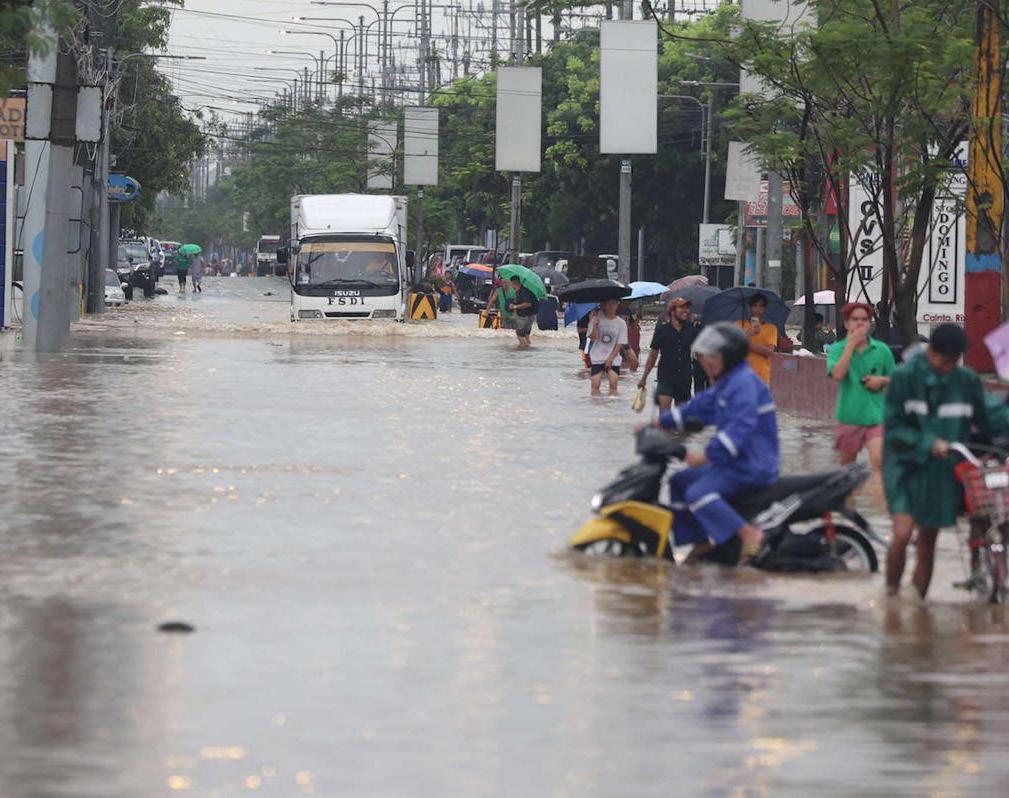

When the local government unit doesn’t suspend classes amidst heavy rains, I am almost certain to be sent to the clinic the next day.
I go to school by motorcycle which my father drives. Even if I wear raincoats, it is inevitable that droplets will seep through onto my skin. Roads with knee-deep floods along Novaliches to Sauyo are also unavoidable.
aside, traveling on two wheels is also much more dangerous on rainy days— from slippery streets to drenched, angry drivers. A decade of this mode of transportation taught me that.
school, I’d sit in front of my father as I was not big enough to ride at the back. I’d hold up our big umbrella to shield my and my father’s heads as rain hit my face with our vehicle’s velocity. My things would be in a garbage bag sitting on my lap so they’d be safe from the floods—one wrong move and my bag would be swimming in the waters.
bottlenecked roads and it was the rainy season, I was introduced to more dangers. When classes would not be suspended despite inclement weather, everyone on the road would rush to get to their destination.
There were multiple instances where the driver of the PUV I was on got into road rage incidents. Passengers took longer to board as it was raining. Angry motorcycle drivers would block our PUV and
days, he takes an hour longer on the way home for his safety, missing the window for delivery. He loses that income for the day.
Despite all these struggles, I don’t ask for the local government to suspend classes every time the weather proves unfavorable. That would be counterproductive for a country so vulnerable to climate change.
” What I hope for is that government officials pay attention to what makes transport unbearable in bad weather.
Congested lanes, overflowing vehicles, and blocked drainages make transportation such a hurdle whether you ride the PUV or the motorcycle. These are the things I think about when the rain hits my face on the backseat. I think about the elected officials who make these decisions for me, for us, who are most likely in their air-conditioned cars, safe from the rains. I try to think of
classes came in Grade 9, my school was four full barangays away from my house. I had switched to public transportation to give my father a break. For a few months at the start of the school year, I would wait for a public utility vehicle (PUV) and ride a pedicab to get to Pisay.
live in an area with
typhoon-stricken









Class suspensions are nightmares disguised as miracles.
It is 11:30 AM on a Tuesday and the Quezon City government has just suspended classes. As the classrooms around ours erupted with joy, I enjoyed the short break I was given— momentarily free from my schoolwork. I wasn’t burdened with my usual troubles of traveling home. I was free.
Safety in mind
Do you remember Supertyphoon Karina?
Life as a Pisay scholar and as a commuter is hard— from having to run across Agham Road, snuggling in with crowds on the EDSA carousel, to running up the stairs to catch the train on the LRT-1.
I even have to pray not to get soaked in rain or get burnt by the rays of the sun on my walk to the bus station.
It absolutely devastated the Philippines, with even Pisay being directly affected. The floodwater reportedly entered the campus, destroying books and damaging buildings.
importance to the public. Due to this, the Philippines lacks sophisticated weather instruments that could have saved millions of lives.
at school when classes got suspended?
There are a multitude of situations where you were doing something when classes got suspended.

I have seen how class suspensions can determine the health and safety of us iskolars ng bayan. Try seeing class suspensions from a different perspective—try the student who walks 50 minutes to get home. Try the student who commutes for two hours. Think about everyone as a whole.
In a school that brings students together from all over the Philippines, every scholar should be cared for equally. What if a disaster happened because the class suspension system failed us? How would the families of those affected feel?
Class suspensions— when executed properly, make for a better and safer world. As typhoons and incurred flooding become ever more common, they may or may not serve to protect you. Class suspensions are merely just a band-aid solution for the core problem that haunts everyone in this wide world, weather—more specifically climate change. I am not the only one who is affected by this. Everyone gets affected.
Inconvenience in convienience

There are many valid points against suspending classes from the lack of rain to time consumption, the list goes on.
The system for class suspensions is flawed, yes, but in both a good and bad way. It tries to ensure the safety of every student, albeit being built on a severely wonky foundation. PAGASA has long been underfunded despite its
These weather services fall short on reliability, as we have seen with the multitude of failures in both defenses and forecasts. LGUs have continuously suspended classes at the last minute because of this.
Coming from a person who lives at least one hour away from Pisay, I am not satisfied with the system for suspending classes.
Frankly, a #WalangPasok announcement at 4AM is simply far too late... ”
for me and others who travel far to reach Pisay.
When I commute, I have to rely on the weather to not douse me in rain, not to burn me to a crisp, but just be good enough to travel home safely.
Every student suffers from bad weather.
Every class suspension is built on a large mountain of details, ranging from PAGASA weather forecasts to the desk of Mayor Joy Belmonte to the state of infrastructure, the variables are endless.
The oddity and complexity of how class suspensions work to release at the right time—hopefully, is for another article or another piece for another time. What is important is that it releases just at the right time, at the right place, and at the right moment to ensure every student’s safety.
When the Information Office sends the email suspending classes, time stops—and plays back. Does that also happen to you?
Final verdict
I do not appreciate how class suspensions are handled—especially given the difficulty being a commuter.

Bad weather causes class suspensions. What time do classes get suspended? Nobody knows. Should classes get suspended earlier? Yes. There are a span of students who go to school everyday, me included. We all suffer just as much if classes get suspended too late in the day, more suffrage for those who walk or commute to or from school.
Time stops—and plays back
Have you ever been anxiously waiting for that walang pasok announcement as the weather worsened? Me too!
Have you been on the journey to school when classes got suspended? Are you a dormer that was eating breakfast when classes got suspended? Were you already

The unreliability and unsophisticated nature of our weather services have led us to this conclusion that leads to a complete failure on the government’s part, being good at times while being terrible in others—namely suspensions in honestly good weather.
Consequently, everyone suffers in class suspensions—even if it’s for our own good. As classes get suspended, schedules shift, time is wasted, and lesson plans change. With midquarter exams and end of quarter exams all around in a quarter, it eats up valuable time to fully understand the material, involuntarily learning nothing in the process.
The final verdict is that class suspensions could and should be improved.


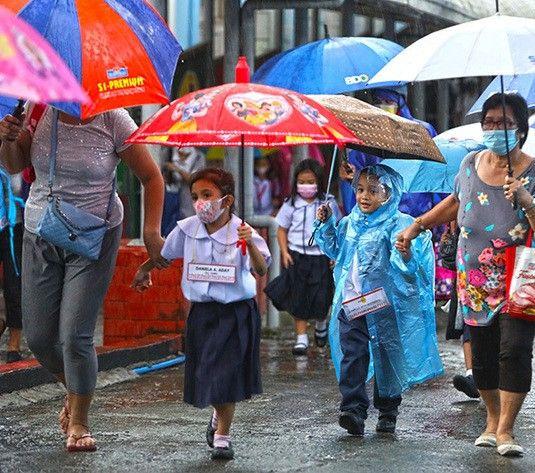


As the Philippine Science High School–Main Campus gears up to celebrate its 60th anniversary with a week-long Foundation Week initially scheduled on September 2 to 6, 2024, typhoon Enteng made landfall the same week.
The first floors of the Science and Humanities Building and dormitories were flooded, causing papers, books, and other supplies to be submerged. The typhoon caused several suspensions and eventually the postponement of Foundation Week.
Led by Pisay 60 Ad Hoc Committee Chairs
Ms. Melodee Pacio and Mr. Mario Danilo Llanura of the Math Unit, the Foundation Week featured events such as a student-wide sports fest, exhibition games between teachers and students, and a variety show featuring performances from faculty and staff.
“When we were told by people na may possibility na bumagyo that week, parang I was in denial pa. Nag-sink in lang siya Wednesday, when the Blair Ramirez
With each new wave of policies arriving seemingly overnight, students are left with one nagging question: What’s next for Pisay? This question echoes in the halls, is whispered between classes, and is debated within group chats.
We cannot deny that policy shifts are inevitable, but the return to a more structured system from the pandemic setup has brought not only stricter policies but also growing concerns within the student body. As these policies stack up, students are left with bigger questions: How will they respond amidst these adjustments?
How will they ensure that their voices are heard?
The New PE Uniform Policy
alumni talks got canceled,” shared Ms. Pacio.
(When we were told by people that there was a possibility that the typhoon would fall that week, I was still in denial. It sank in on Wednesday when the alumni talks got canceled.)
Some alumni were invited back to PSHS–MC for plenary talks in a series entitled, “Back to the Nest: an Alumni Anthology,” to be attended by students. However, due to the typhoon, the talks were suspended.
Mr. Llanura stated that the cancellation of the alumni talks saddened him the most.
“Some of them are my students, some are my batchmates pa, mga ate and kuya namin when I was a freshman here, so doon ako saddest kasi people flew in just for the event.”
(Some of them are my students, some are my batchmates, and some are my seniors when I was a freshman here, so that’s where I was saddest because people flew in just for the event.)
The suspension was a challenge not only to the Pisay 60 chairs, but also to their committee members because of other commitments.
Some faculty members and administrative staff backed out of their variety show performances due to conflicts that arose from the typhoon.
As festivities were rescheduled to October, students had mixed views on the new schedule and Foundation Week itself. Students expressed how the celebration felt rushed.
Gavyn Santiago, a student from Batch 2027, stated that it would have been better if Foundation Week started the week after the periodical examinations.
“Personally, I share the sentiment that there should be ample buffer time between academic days and special events such as the Pisay 60 celebration, which is often achieved by weekends separating acads and events.”
Despite the challenges, the Pisay 60 Chairs have no regrets or apprehensions.
“Pisay 60 is not the work of two people…All of these adjustments that we had to do, nagawa namin ‘yon because we had a lot of help from our committee members and from our sponsors,” Ms. Pacio shared.
(Pisay 60 is not the work of two people…All of these adjustments that we had to do were possible because we had a lot of help from our committee members and our sponsors.)
Mr. Llanura added that some of the sponsors were parents of alumni and other alumni that fellow teachers knew.
“Pisay 60 is a testament to how closely-knit we are as a community; so I am hoping that in the coming years, that spirit of the Pisay community will be exhibited more,” Ms. Pacio stated.
While the intentions of fostering a professional approach are clear, many feel that it is an unnecessary change that adds an extra burden. Having to change uniforms has proven to be a hassle for both students and teachers, with several students reportedly arriving late to their next class because they were occupied with changing.
Dormers struggle with limited access to laundry, while most interns find it challenging to maintain a sufficient supply of clean uniforms, making frequent changes impractical for both groups.
The Director’s List Award is a coveted reward that almost all scholars in Pisay strive for. During the SY ‘23-24 orientation, new qualifications for the Director’s List were announced. To be recognized, students must have a GWA of 1.50 and above for the 4th quarter of the preceding school year, instead of maintaining this GWA across all four quarters as previously required.
of the best assets a student can utilize. The convenient nature of the previous schedule enabled students to easily keep track of their day and plan it out efficiently. The old schedule featured 45-minute periods, 15-minute breaks, and a 45-minute lunch, starting at 7:30. However, the new schedule starts at 7:20, shortens breaks to 10 minutes, and extends lunch to 55 minutes.


One of the policies reinstated from the prepandemic setup is the mandatory uniform change before and after PE class. What was once a more flexible system, where students could wear their PE uniforms throughout the day, has now become a strict rule that limits the wearing of the PE uniform during PE class only.
In response, the batch councils took the initiative to raise these concerns with the Student Discipline Office (SDO), successfully providing the administration with perspectives they may not have considered when forming the policy. “In the end, it’s for the students,” Batch 2028 Council member Rubix Reyes stated. While policies like this are sparking conversations of amending and reverting the changes to fit students’ needs, new approaches such as changing the Director’s List qualifications and schedule time intervals are bringing up questions of their necessity and the effects on the community.
The reception towards this new policy is mostly positive and well-received. The general consensus is that it gives students much-needed time to work on this goal. However, there are some who feel that this new policy undermines the achievements of consistent Director’s Listers, as it gives more people the accessibility to achieve this with arguably less effort.
Nonetheless, many agree that the policy ultimately serves a positive role in this school. As more students gain this prestigious award, it seems this policy helps in cultivating a motivating and positive environment.
A systematic and well-organized routine is one
According to the interviewees, the adjustment felt unnecessary and has been a challenge to adapt to. Both students and teachers have occasionally been thrown off by this new schedule, resulting in missed or delayed classes as everyone adjusts.
The controversies and complaints surrounding the new schedule may be due to its recent implementation, and an adjustment period is needed to fully understand its impact on daily life.
The Student Body and the Administration
The pressing question remains: What’s next for Pisay? Students believe that they deserve a seat at the table, with a voice in decisions before they’re set in stone, especially since they’re the ones most affected by these changes.
Many students felt that their voices were left unheard before these policies were enforced, leading to widespread confusion.
Moving forward, a stronger partnership between the administration and students is essential. The administration must ask for students’ opinions on the policies before implementing them. This way, they can consider any possible aspects they may have overlooked when establishing rules. Moreover, the changes shouldn’t be implemented abruptly; instead, they should be announced at least a week before being made permanent. By creating dedicated channels for student feedback that allow students to voice out the problems they face, along with solutions that can alleviate these struggles, Pisay can pave the way for a more adaptable, and supportive environment.





Blood red stained the header of the SeptemberOctober 1971 issue of The Science Scholar, where the bold words “Pierce the enemy with your pens! Restore the writ!” dared to confront a regime on the brink of tyranny.

Pisay’s extensive history of activism is no secret. With students’ voices unshaken by fear, they embodied what it meant to be a scholar: the relentless pursuit of the untarnished truth.
The 1960s: the birth of the campus press 1964 marked the birth of The Science Scholar—in black-and-white, simple fonts, and typewritten pages that gave voice to young scholars. It hailed itself as a necessary school organ, not to glorify the school, but to follow the happenings of the nation with a questioning eye.
1970: The First Quarter Storm, and Pisay’s brewing fight for national democracy
“ Activism not apathy
In The Science Scholar’s 1970 January–February issue, an article pled about complacency on the header.
The 1970s would be the turning point for Pisay.
The regular school news, dorm stories, and the What’s New in Science section of SciScho would change. Ang Lagablab emerged with its first issue on activism, and consequently, the campus press’ tone shifted
radically.
In the July-September 1970 issue, one article in particular stands out. “The Need – Cures, not Relievers,” whose first lines describe the Philippines as ruled by the US imperialists and bureaucrat capitalists. In the words of the article: “DEMOCRACY and SOCIAL JUSTICE seem nothing more than empty slogans.”
In the cracks of martial law
On September 21, 1972, Ferdinand Marcos declared martial law. Publications were shut down, journalists were arrested and detained, activist organizations were driven underground.
The campus press was no exception: The Science Scholar would breathe its last
issue just a month prior. When SciScho returned in 1974, its pages were eerily silent—absent of the radical voices that had once defined it.
The campus press was no exception: The Science Scholar would breathe its last issue just a month prior. When it returned in 1974, its pages were eerily silent—absent of the radical voices that had once defined its pages.
In the Oct-Nov 1983 issue, The Science Scholar revealed how it was censored after Ninoy Aquino’s assassination. A column about the Liwasang Bonifacio rally was removed by the guidance counseling unit before printing. It was later disclosed that each issue had to be submitted for approval and the unit had complete control over what was put into print.
The fight for a free press and democracy
Censorship may seem like a thing of the past, but Filipinos continue to struggle for freedom of speech. Activists, journalists, human rights workers, and the toiling masses are still fighting for national democracy.
Since 1986, hundreds of activists and journalists have been killed. For years, our country has been recognized as one of the most dangerous places for journalists, even once ranking as the second most dangerous after Iraq.
If we are truly a democratic country, why are the people’s voices being silenced?
The fight for national democracy does not end. For as long as voices are silenced, there will lie a continued struggle.
And it is our duty, as Filipino scholars, to fight for it.

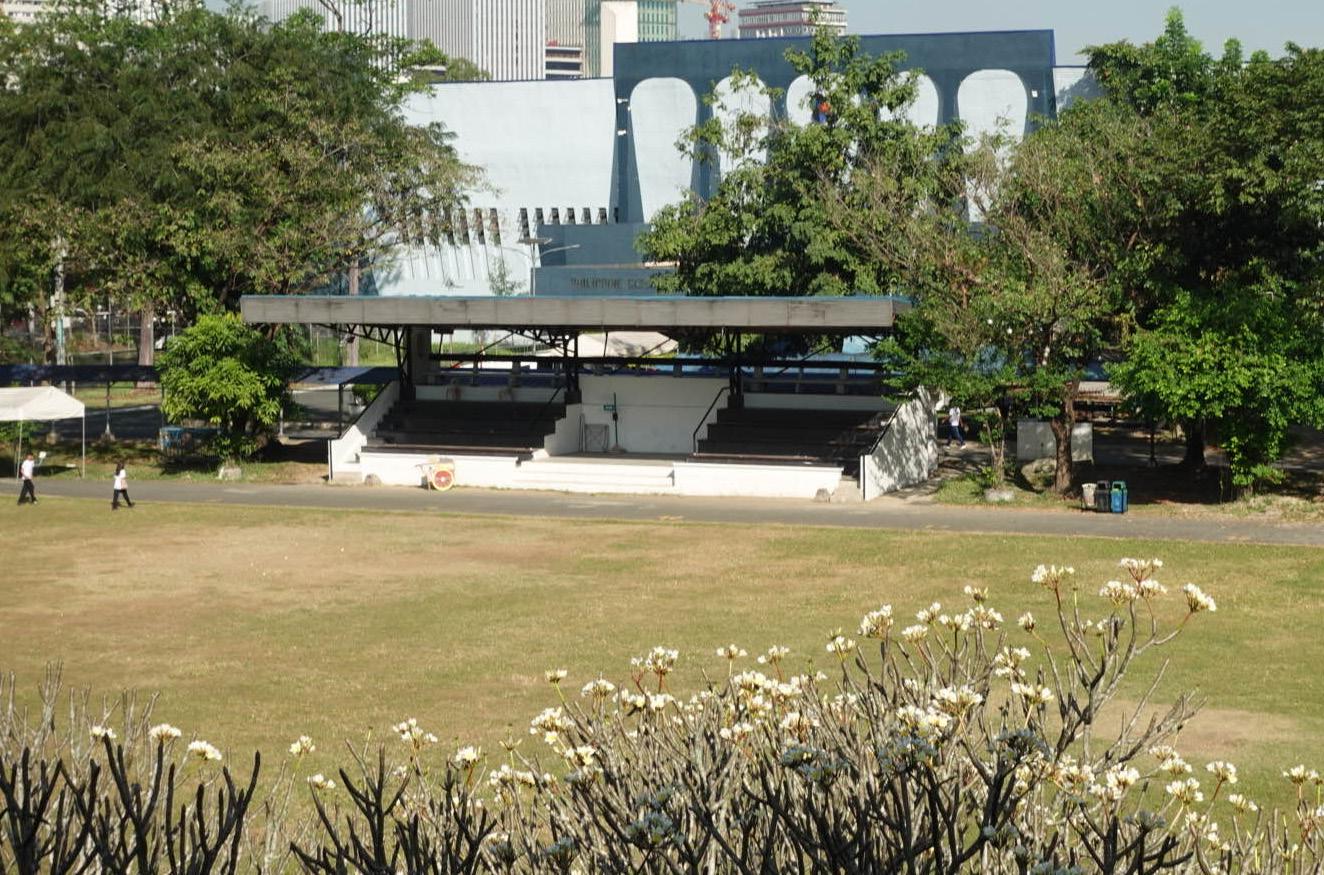
Protecting students of Philippine Science High School–Main Campus, a lightning rod beside its grandstand serves a reminder of the lightning strike that took the lives of two Pisay students, Roland Madamba and Randy Quinan.
The grandstand is a backdrop for many students’ fond Pisay memories, from hangouts to project practices. Even so, the history behind it is not talked about nearly enough.
Flash of White
Contrary to popular belief, the Friendship Grandstand was not built after the students’ passing, but before it. However, it was the inspiration for their batch’s renovations of the grandstand in 2004.
The declaration of Martial Law in 1972 left the PSHS–MC administration no choice but to close the school for around two months, delaying the school year’s timeline such that students finished up their year in midMay.
As the school year was ending, most students were there to do their clearance requirements—Madamba and Quinan among them. At the time, Pisay had two buildings: the then-new Science and Humanities Building and the old one which students referred to as “Prefab.” Previously on the current land of the Gymnasium, the old building was the students’ next destination.
As they trekked on the field, the peace was interrupted by a flash of lightning, hitting the two friends. They were brought to the nearby hospital where they were pronounced dead on arrival.
In response, Pisay held a wake in the then-cafeteria on the following day. They then installed the lightning rod and constructed the roofed walkways to keep students safe—installations that are still used today.
Honoring Madamba and Quinan
Most believe that the grandstand was sponsored by Batch 1974, Madamba and Quinan’s batch. However, their batchmate, Dr. Gigi MedinaLavadia, debunked this, clarifying that the grandstand was already there before the incident.
It was only over three decades later that the Friendship Grandstand officially adopted this story and stood as a symbol of friendship. In their 30th homecoming, Batch 1974 commemorated the loss of their batchmates by taking over the maintenance of the grandstand.
“[The grandstand] will serve as a memorial to friendships made during that time, during our youth,” Dr. Medina-Lavadia shared.
As part of their adoption of the structure in 2004, they redesigned the grandstand. Its back was opened to provide better ventilation and its roof was replaced and extended to the rear side. They also added tiles, granite, a ceiling, lights, and fascia.
Their batch also added the plaque in the Friendship Grandstand, which reads, “This grandstand is a memorial to friendship forged in the flame of youth.”
To this day, Batch ‘74 continues to maintain the grandstand. On their 50th anniversary in 2024, they repainted it, replaced light fixtures, installed a new plaque, and replaced or repaired tiles.
Fulfilling Their Legacy
Besides ensuring our safety, the Friendship Grandstand reminds us to appreciate every fleeting moment in our high school lives.
Dr. Medina-Lavadia advised Pisay students: “Treasure the moments you’re together, and realize that life is short but still very valuable.”
The Friendship Grandstand is not only a memorial and symbol of Madamba and Quinan’s friendship, but of every bond and memory made. Hopefully, the incidents of the past and the symbolism of the Friendship Grandstand may remind us to value our time with the people around us and make the best of it.
“ Time may pass quickly, but the echo of the moments we share lasts forever.
v
Thandie Aliño
Saan aabot ang 50 pesos mo?
From September 25 to October 15, the Metro Manila Film Festival (MMFF) held “Sine Sigla sa Singkwenta,” wherein 50 of the most beloved past MMFF entries were screened in select cinemas for only 50 pesos each. The campaign was meant to honor the festival’s 50th anniversary and engage the public in Filipino cinema.
“With the Sine Sigla sa Singkwenta screenings, we will bring some of the most memorable MMFF films back to the big screen… allowing both new audiences and long-time fans to experience the magic of those beloved films once again,” said MMFF Overall Concurrent Chairman Atty. Don Artes during the September 19 launch of the commemorative event.

A complementary handpainted mural was also unveiled along EDSA, displaying portraits of some of Filipino cinema’s most iconic actors, including Nora Aunor, Vilma Santos, Dolphy, Eddie Garcia, and many more.
Such an elaborate celebration could only be expected for something like the MMFF, the most famous and highest-grossing film festival in the Philippines. Containing only Filipinoproduced films selected by a board of jurors, the festival runs
Ungkatan ng (complicated) past!
The MMFF as an institution has unsavory origins within the Ferdinand Marcos regime. It was conceived in 1975 as one of Former First Lady Imelda Marcos’ many cultural projects meant to distract from the atrocities of Martial Law.
Despite being an extension of the Bagong Lipunan program, the MMFF ended up playing an important part in the Second Golden Age of Philippine Cinema, notable for its indictment of the Marcos regime and its abundance of relevant social commentary about poverty and oppression.
to perform at the box office. And even then, the 2016 edition was considered high risk with low rewards; it garnered less than half of the billion pesos earned the previous year.
Back were the predictable and critically panned yet “commercial” films the following years. The same MMFF that had released Die Beautiful and Sunday Beauty Queen was now back to releasing drivel like Fantastica and Otlum only a couple years later.
This is partly why some still view the MMFF with apprehension; what kind of film festival so blatantly guns
Firefly, and Jun Lana’s Die Beautiful and Big Night!
This lineup is the perfect portrait of the MMFF as both a film festival and overall reflection of Filipino culture. Here is the MMFF in its best form as a platform for artistic auteurs, as a commercial medium, and as an institution aiming for a brighter future.
To reflect on such a complicated legacy through only 50 films? It’s one of the festival’s most admirable feats so far.
Art by Nico Hechanova
Titles like Uninvited (starring Vilma Santos and Nadine Lustre) and Espantaho (starring Judy Ann Santos and Lorna Tolentino) are also gaining buzz for their casts of formidable actors, many of whom hail from past MMFF films.
All these factors—mixing veteran actors with newer talent, showcasing the versatility of comedians, offering a wide array of genres, and rehashing and reinventing the past—reveal a gamble the MMFF may be taking in light of the current Philippine filmgoing landscape, wherein Western blockbusters and streaming are king. The MMFF seems to be leaning slightly away from its mainstream tendencies, in favor of original stories and new takes on old classics, to cater to an audience tired of formula and the very act of going to the cinema.
This is a welcome development for a Philippine film festival as prevalent as the MMFF. While Cinemalaya and QCinema festival films are already expected to deliver original and artistic stories, they do not have the nationwide reach of the MMFF.
Though the festival is not the be-all and end-all of what the Philippine film industry has to offer, it can be a good starting point for audiences seeking out Filipino cinema. The Sine Sigla sa Singkwenta and the 2024 MMFF





nationwide from Christmas day to the first week of January. Through this period, the only films playing in cinemas are from the MMFF. There is even a preceding Parade of Stars, wherein actors from participating movies ride on their respective floats through a crowd of fans.
The MMFF has since gained a bevy of mixed opinions since its inception. Some see it as a beloved holiday staple; for some families, it is tradition to go to the MMFF during Christmas. Some also appreciate it for uplifting Filipino films, especially at a time when streaming services and blockbusters dominate the current landscape of cinema. On the other hand, it has recently inspired think pieces about its waning relevance, especially concerning its inferior quality and commercialized output.
So what better way to probe the festival’s influence than through a retrospective of its inception up to its legacy as a cultural marker?



Filmmakers such as Lino Brocka, Ishmael Bernal, Mike de Leon, and Celso Ad Castillo were able to debut their respective films — all metaphoric criticisms of Martial Law — Insiang, Himala, Kisapmata, and Burlesk Queen at the MMFF.
This was a massive deal, considering the Letter of Instruction No. 13 in 1972 banned the public exhibition of films that incite rebellion against the State or undermine the people’s faith in the government.
Other notable auteurs the festival has hosted include Marilou Diaz-Abaya (Moral), Chito S. Roño (Dekada ‘70), and Mario O’Hara (Bulaklak sa City Jail), all of whom are legends in contemporary Filipino cinema.
However, in the succeeding years, the need for profit overpowered the prioritization of artistic merit within the festival. Slowly, mainstream action flicks, comedy movies, popular franchises, and love team vehicles dominated the MMFF, triggering an era of commercialization bolstered by big-name stars and Hollywood-style narratives.
Until 2016, 50% of the selection criteria for MMFF films went to “commercial viability,” or its potential



for profit over artistic merit? Though the MMFF has slightly bounced back from audience fatigue as seen by its recent inclusion of diverse entries by acclaimed filmmakers, with the 2023 entry Rewind even becoming the highest-grossing Filipino movie of all time, there is still much room for its improvement as a cultural institution.
A golden jubilee for the silver screen
As such, Sine Sigla sa Singkwenta was a fascinating exploration of the varied legacy of the festival itself, all while still being affordable for Filipino moviegoers.
Its lineup includes classics that tell uniquely Filipino stories, ranging from films grappling with our colonial past (Ganito Kami Noon… Paano Kami Ngayon, José Rizal) to the struggles of women within our patriarchal society (Insiang, Marilou Diaz-Abaya’s feminist trifecta of Moral, Brutal, and Karnal). Fixtures of Pinoy pop culture like Shake Rattle ‘n Roll, Mano Po, and Darna complete the lineup.
Recently acclaimed films have also taken the spotlight, like OFW documentary Sunday Beauty Queen, 2023 MMFF Best Picture winner


Ganito kami noon, paano kami ngayon?
Delving into MMFF’s history, one can’t help but wonder: where does it go from here?
Though this year’s lineup has yet to be viewed at the 50th incarnation of the festival this December 2024, a quick look at the ten films announced tells a story of simultaneous retread and revitalization of past films and famous figures within MMFF’s history.
Notably, two famous comic actors are swerving from their comedic careers into dramatic territory this year. Box-office darling Vice Ganda is starring in Jun Lana’s dramedy And the Breadwinner is…, while Eat Bulaga! alum Vic Sotto is embarking on his first dramatic role in The Kingdom. The 1982 classic Himala will also be reimagined as Isang Himala, a musical retelling courtesy of Pepe Diokno and National Artist Ricky Lee, who has also co-penned Green Bones, another 2024 entry.
The usual MMFF genre fare, namely romance (My Future You and Hold Me Close), horror (Strange Frequencies: Haunted Hospital), and action (Topak), is likewise present.



entries are steps to a bright future for the festival. Therein lies a glimpse of what could happen if it left behind its era of mindless commerciality for a new one that will consider the state of our country more potently.
Audiences go to film festivals to be in a community as they explore different, diverse stories. In this case, the MMFF is supposed to reflect and influence the current landscape of Philippine cinema and culture. That is why the MMFF must keep reinventing itself. If we keep seeing the same kinds of movies every single year, then what does it say about our culture? Our country? Us as a people?
Should we let the drive for profit overshadow the very real possibility that we could be depicted as a stagnant nation?
If the MMFF wants to maintain its relevance and transcend its weaker years, it must embrace change. After all, the best films reflect our evolving world, and the best film festivals celebrate that fact.


Raphy Santos


September 1st. For the rest of the world, it’s just another day.
It’s the ninth month: the world inches closer and closer to the end of the year, but an ordinary month nonetheless.
But for us Filipinos, it’s the first -ber month, and it’s time to dust off the holiday decor.
Shopping malls set up faux-snow photo-taking areas and three-story-tall Christmas tree spectacles. And at home, families begin planning Christmas sale shopping sprees. Jose Mari Chan begins his yearly rounds and nativity replicas make their way onto living room tables.
It’s a whopping 115 days before Christmas—a countdown that seems too negligible for the rest of the world to care. But for the Philippines, it’s the beginning of an important part of the Filipino experience.
Tracing it back
Historical perspectives have traced the holiday back to the very first records of Simbang Gabi in the country. At that point, Christmas was unheard of, having just arrived in the Philippines. But it played a small albeit important role in the Spaniards’ greater agenda: to replace the Filipino’s precolonial beliefs with Christianity. And so they held these Simbang Gabi masses at the break of dawn to avoid the scorching heat
of the tropical sun and allow busy farmers to catch the service.
With Simbang Gabi came several other traditions in the same Catholic vein. Panunuluyan became a Christmas Eve countdown; as towns awaited midnight, they gathered round and watched a troupe of costumed actors re-enact the nativity. Noche buena also became an anticipated celebration among Filipinos, who used the event to go on shopping sprees or lay the table with huge spreads.
These traditions ushered Christmas into the Philippine zeitgeist—Felices Pascuas, as Filipinos called it back then. But this Christmas, clocking in at under a month, wasn’t yet the four-monthlong celebration it is now. As time went on, Filipinos eventually made Christmas their own with distinctly Filipino traditions. From parols and street carols to
“
The lengthy holiday season isn’t just any ordinary countdown, but a manifestation of how much this holiday has meant to Filipinos for so many generations.
extended family reunions and ampao envelopes, the Christmas celebration evolved well past Spain’s attempts at religious control.
By creating traditions of their own, Filipinos reframed Christmas using the values cultivated on their own accord, finding autonomy amidst the watchful eye of the Spaniards. Part of this reclamation was a longer, more secular Christmas.
But why?
Conflicting perspectives have long attempted to explain such a lengthy Christmas, each of which points towards a different facet of the country’s identity.
for businesses, the four-month-long Christmas season means four months of holiday increase, giving them all the more reason to uphold this festive tactic for as long as possible.
Others, however, see this months-long season as a manifestation of our fondness for shared celebrations. With countless festivals and party traditions decorating the Filipino calendar every year, Filipinos long have had a liking for celebrating anything and everything. With Christmas being no exception, it may even be the biggest celebration of them all.

Tea J.

Many have taken a pragmatic stance on the long Christmas season, attributing its length and gravity to Filipino consumerism and commercialization. For them, the malls and shopping sprees integral to the Filipino Christmas experience are part of a bigger picture of the capitalism that enables it.
For them, Christmas has grown not only beyond novenas and other religious traditions, but beyond the Filipino values that they seemingly uphold. The holiday has become a mere marketing tactic for brands and establishments to maximize profit. The outlandish decor in shopping mall interiors only serves to bring the crowds in, and Christmas sales to skyrocket purchases. And

The 115 days may be long to most, but for Filipinos, it’s a countdown to the most important celebration of the year. For Catholics, it’s perhaps the most important day in their religious canon. For extended families, it’s a time when all of them can be in the same place and share a celebration across generations. And for many working Filipinos, it’s one of the only occasions where they can spend uninterrupted time with their families.
These seemingly disparate perspectives are what make Christmas what it is now.
For the rest of the world, September 1st is just another day. But for us, it makes all the difference. And once the Christmas bells begin to sound, Filipinos will be sure to make the countdown worth every single day.


When scrolling through your Tiktok FYP, you’ve probably seen the resurgence of butterfly clips, Juicy Couture tracksuits, and low-rise jeans. As these styles and aesthetics resurface into the public consciousness, are we simply reminiscing about the 90s and aughts, or are we subconsciously bringing back the worst parts of those eras?
Beneath all of the glitz and glamour of the 90s and 2000s lies the hidden truths of racism and body dysmorphia that shaped them nearly two decades ago. The comeback of such aesthetics tells a story of not just fashion, but also how our society has failed and refused to evolve.
Trends in the fashion industry come and go—what may be seen as trendy today will become the “cringe” items of tomorrow, or they might find themselves back into mainstream fashion around 20 years later. This 20year cycle is the reason why our social media feeds are filled with people who look as if they had just stepped out of a Y2K-era Britney Spears or Avril Lavigne music video with their lowrise jeans, chunky highlighted hair, baby tees, and bedazzled clothes. However, the resurgence of such trends fails to acknowledge how the fashion industry cleansed itself of commodifying Black culture and im-
posing unrealistic standards. After all, our sense of nostalgia is selective—we cherry-pick all the fun and hide the harm under the rug.
The 90s and Y2K fashion styles did not just appear out of thin air—they were popularized by Black artists considered the “It Girls” of their time. These include Aaliyah, who frequently sported leather tops, bandanas, and oversized logomania jackets, as well as Destiny’s Child with their bedazzled thongs, low-rise jeans, and maxi dresses.
However, as these looks resurface in today’s fashion, their origins and cultural context have been dismissed and distorted in mainstream circles.
Nameplate necklaces, which have long been a staple of African-American and Latino communities, were dismissed by Sex in the City’s Sarah Jessica Parker as “ghetto” and “just for fun”.
These trends are appropriated by white culture once they have been stripped of their Black roots, and only then will they be considered acceptable by the very culture that labeled them as “ghetto.” Moreover, Logomania, pioneered by Dapper Dan with his use of luxury brand logos as patterns, are often dismissed as a sign of “new money” or “tackiness”, reinforcing how Black contributions to fashion are marginalized.
These styles tell an alarming story of how fashion rooted in POC cultures is dismissed and looked down upon until mainstream white culture decides it’s fashionable. Cultural expressions manifested through fashion are first mocked, stolen, and then sold back to the world as “new versions” of trends, with their origins and meanings divorced from the communities that gave them life.
Size-zero or woman worth zero
Beyond racism, the 90s and Y2K fashion came with a large dose of diet culture, where seemingly everyone was obsessed with thin, sizezero bodies seen through models like Kate Moss. While crop tops and lowrise jeans were all the rage, it was an unspoken rule to have stick-thin arms and legs, a wide thigh gap, and a flat stomach to look good in such clothes. This idea was further perpetuated in magazines, TV shows, movies, and other forms of media consumed in the era.
In The Devil Wears Prada, Anne Hathaway’s character is frequently ridiculed for being “fat,” as if a woman’s worth was tied to how much she could fit into the current beauty standards. Such treatment is seen not just in fiction but also in real life: At a 2009 concert, Jessica Simpson was shamed for wearing high-waisted jeans as she was not as thin as she was when she played Daisy Dukes. The
trends of the times made it a point to dehumanize women, reducing their worth to the perceived values of their bodies.
As 90s and Y2K fashion trends are making a comeback to the mainstream, so are its body standards, where low-rise jeans remain inaccessible to anyone who doesn’t possess the thin, no-curves body type. The message remains: if your body doesn’t look attractive in those clothes, you have no choice but to skip the trend.
On TikTok, there is a resurgence of “thinspo” culture where people show off their tiny waists, making their young followers begin to question whether their bodies are good or thin enough for certain clothes. While the values of exercising and eating right that come from this “thinspo” culture are important to maintain one’s health, it stops being healthy when teens start starving themselves to fit into clothes that mimic their favorite influencers.
Body positivity and a healthy relationship with food are increasingly recognized as necessary values; yet, we continue to glorify trends that exclude people who don’t fit unattainable standards.
setback?

unwilling to confront the problems of our past and instead tend to repeat them. If we continue to allow this racism and body dysmorphia to become normalized, we risk a repeat of the same mistakes from decades ago. So, it is time to ask ourselves: are we simply engaging in a fun throwback, or are we participating in a regression

The return of 90s and Y2K aesthet ics in fashion isn’t just a trend but a symbol of how we as a society remain



Kayleigh So & Janna Vega
For many Pisay students, it’s a familiar sight: students running in the field and passing a frisbee around, gathering to enjoy the outdoors and spark friendly competition. But have you ever wondered what makes a frisbee fly so gracefully through the air?
The answer lies in the fascinating world of physics.
The flight of a frisbee is a classic example of aerodynamics—the study of how air interacts with solid objects. When a frisbee is thrown, it must keep spinning to fly almost parallel to the ground. If you throw a frisbee into the air like a ball, it likely won’t

travel far before falling. This is because the frisbee requires a certain level of stability during its flight, which is achieved through angular momentum. Angular momentum refers to the amount of rotational motion an object has. When a frisbee is thrown with a high angular velocity (a quick spin), it gains more angular momentum. This enables the frisbee to maintain a more stable flight path. Meanwhile, frisbees soar through the air because of their generated lift. Lift is a force that “lifts” the frisbee against the pull of gravity— the force that attracts objects to the earth—allowing it to


remain airborne.
This lift is generated through Bernoulli’s principle, which states that as speed increases, pressure decreases. As a frisbee moves through the air, it causes the air above to travel faster than the air below. This means that the faster air above the frisbee has a lower pressure, while the slower air below has a higher pressure. The higher pressure underneath creates a force acting upwards on the frisbee, generating lift.
While lift is the force that keeps the frisbee up in the air, drag opposes the motion of the frisbee. This drag is a result of the air pushing against the frisbee, slowing it down.
The frisbee’s rounded edges help reduce this drag, similar to how the rounded fronts of missiles and submarines allow them to move smoothly through fluids like air and water.
To achieve the maximum travel distance, the ideal launch angle for a frisbee for maximum lift is around 10–20° relative to flat ground. If thrown at too steep an angle, it presents more surface area to the oncoming air, increasing drag and causing it to lose

speed and fall quickly—similar to how a hand held flat against the wind feels more pushback than a hand held sideways. Meanwhile, if thrown too low, the frisbee may lack sufficient lift to stay airborne. Several other factors also affect how a frisbee sweeps through the air. Wind conditions are especially crucial—throwing against a strong wind requires a more powerful throw, while a tailwind (a wind blowing behind the frisbee in the same direction as its travel) can help extend the distance.
The frisbee’s material and design also contribute to its performance. Most modern frisbees are made from lightweight plastic that can
withstand impacts and provide a good grip. A wider rim provides more lift, while a narrower one allows for faster spins.
If you’ve ever tried it, you’d know that it’s difficult to master the right throw for a frisbee. Hopefully, understanding the physics behind it—a combination of high speed, fast spin, and a 10–20° angle of attack—lessens the number of times one must yell “heads!” before getting it right. Next time you see Pisay students tossing a frisbee, remember that behind the fun lies the science of flight. So, grab a frisbee, find your angle, and let science take over!
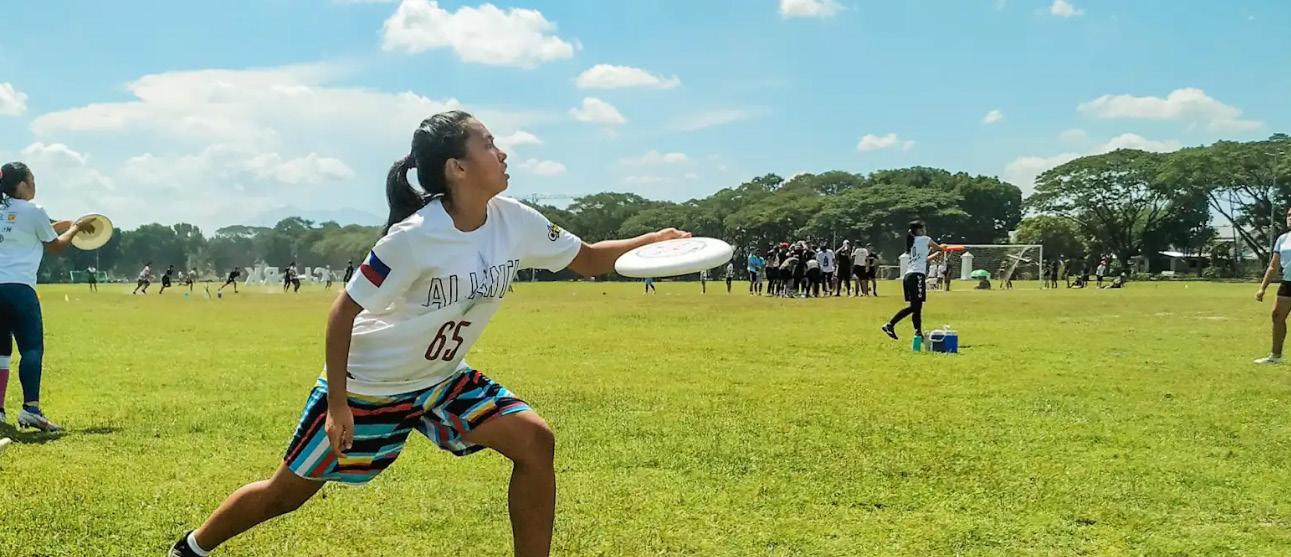


Rhensis Lofamia


With its affordable prices, rare finds, and unique styles, ukay-ukay has woven itself into Filipino fashion culture. In 2022, the Philippines became the 11th largest importer of used clothing in the world.
Ukay-ukay seems like the perfect alternative to fast fashion’s wasteful ways. But as our closets fill with secondhand treasures, a pressing question looms: Is ukay-ukay truly an eco-friendly choice, or is it merely a convenient cover in the fight against environmental degradation?
The Case for Sustainability
The fashion industry is notoriously harmful to the environment. Buying secondhand clothes through ukayukay offers a more sustainable option by extending the life cycle of garments.



Diogn Mortera
The circularity aspect of ukayukay—reusing, repurposing, and recycling clothes—helps reduce the demand for new production. However, there are still environmental tradeoffs to consider.

The Hidden Environmental Costs
While ukay-ukay does promote reuse, items are processed, packaged, and shipped internationally to reach their destination markets. Shipping these clothes significantly adds to carbon emissions due to heavy fuel oil used by cargo vessels. This high carbon cost offsets some of the environmental benefits of reuse and thrift shopping.

Moreover, the surplus of ukay-ukay stores and the never-ending flow of secondhand clothes can lead to overconsumption. When items are cheap, the urge to buy more can transform ukay-ukay shopping from a conscious act into a mindless one, perpetuating a cycle of impulse buying, diluting the sustainability benefits.
Even though ukayukay prolongs the life of clothing, not every item finds a new home. Unsold clothes from these stores often end up in landfills, which perpetuates the very issue that thrift shopping seeks to resolve. In regions where solid waste management is already a significant challenge, this influx of textile waste can contribute to environmental degradation.
Furthermore, many garments sold in ukay-ukay are made from synthetic fibers, such as polyester, which do not decompose easily and release microplastics into the environment when washed. Local Solutions: Upcycling and Reducing Waste
In response to these challenges, some ukay-ukay shops are embracing upcycling, where clothes are creatively transformed into new items, thus extending their lifespan even further.

In Baguio City, several stores collaborate with local designers to turn excess clothes into fashionable, unique pieces. These efforts not only reduce waste but also create a market for customized and sustainable fashion.

The Verdict: A Nuanced Approach to Sustainability
So, is ukay-ukay truly an eco-friendly solution? The answer is nuanced. On the one hand, it provides a practical
Taking his shift in the summer of July 2024, an innocuous worker in NAIA is flashed with the blue screen of death as he attempts to scan his first ticket for the day. Soon, other display monitors by his workspace cascade into shutdowns — signaling a bigger problem than a local computer failure. What happened in NAIA is just one of many computer deadlocks during the CrowdStrike-related IT outage, described as one of 2024’s most impactful cybermishaps. From hospitals to bank payment systems, most of the world’s digital foundations have become bricked—stemming from one
overlooked bug.
Networks of computers are vulnerable to hacking attempts from wellversed cyberspecialists, so corporations invest in antivirus programs, such as Falcon from CrowdStrike, used by 14% of the digital market to protect their machines.
On July 19, CrowdStrike released an update to counter a new data-transfer exploit used by hackers. However, a fatal flaw caused mismatched inputs and outputs in the update’s code. This led the program to continuously search for missing data, consuming all memory and crashing millions
of devices.
NAIA was among many systems hit, alongside media, healthcare, and even Olympic management. The rapid onset of defective devices was an
way for people to make more sustainable choices, diverting clothing from landfills and cutting down the need for new production. On the other hand, issues related to transport emissions, overconsumption, and improper disposal highlight the limitations of this practice.
Ukay-ukay is not a silver bullet for the fashion industry’s sustainability woes. It is a step in the right direction, but it should be coupled with more comprehensive efforts to reduce waste, minimize emissions, and shift consumer behaviors toward long-term sustainability.
As it continues to grow, ukay-ukay offers a unique opportunity to rethink our relationship with clothing, one thrifted piece at a time.
faulty code. Rashik Parmar, CEO of The Chartered Institute for IT, praised their efforts:
“The crisis tested everyone in our industry.

urgent task for information technology (IT) teams, who effortfully scrambled to reset devices and manually fix the
I’m proud so many professionals stepped up, whether advising CEOs, sharing updates, or rebooting laptops.”
Months later, experts stress better safeguards. The principle of extensive testing is especially important in code, written by humans for computers to run — thus, one human mistake can be replicated into millions of computer errors. Other measures in testing include asking for user
approval before updating for more control and smaller-sized update releases to lower the possibility of unseen errors during testing.
Unlike previous incidents caused by malicious attacks, CrowdStrike’s outage stemmed from human error. While antiviruses protect critical systems, users must also stay vigilant about what they install. Despite their speed and efficiency, computers remain rooted in human design—and prone to human flaws. When technology fails, humanity must rely on predigital solutions, even if slower, as experts work to resolve the issue.

was a phrase often repeated during the 2018 Dengvaxia controversy, one that still affects us now, six years later, and will continue to years into the future.
Muddled up in the Senate hearings, the criminal charges, and the numerous reports of dead children, the question still remains: what really happened?
Dengue Fever is a disease spread by infected mosquitoes to humans. As it is transmitted through mosquito bites, it is a threat to tropical regions with high mosquito densities such as the Philippines.
Up to 10-20% of patients die if left without proper medical care, which has made its rapidly increasing spread all the more concerning.
Enter Dengvaxia, a vaccine for Dengue developed by Sanofi Pasteur. It works by introducing weakened viruses to help the body fight against the actual disease.
This vaccine was revolutionary in the fight against Dengue; the first of its kind.
Jared Mancenido
Former president Benigno Aquino III quickly signed a 3.5 billion peso deal.
In 2016, the DOH launched a Dengue vaccination program that focused on vaccinating school-aged children, one of the most vulnerable groups to Dengue.
However, one important condition for the use of the vaccine is that the person receiving the vaccine must have contracted Dengue at least once before. Those who receive the vaccine without a previous infection may be at higher risk of developing severe Dengue in the future.
This condition was only discovered by Sanofi in 2017, upon which they announced it to the general public. However, the meaning of “severe Dengue” was not properly clarified.
“Severe Dengue” describes Dengue with symptoms such as bleeding gums or nose, blood in vomit or excrement, and fatigue.
Without this knowledge, many panicked, believing those who had received the vaccine were at risk of dying.
News agencies reported stories of dead children and weeping parents, while
the Public Attorney’s Office conducted several highly publicized autopsies that supposedly linked the vaccine to the deaths of children.
The causes of death of the autopsied children were listed as due to rare viscerotropic and neurotrophic-like diseases caused by Dengvaxia. Such claims have been challenged by experts, including the Philippine Society of Pathologists, with evidence pointing towards natural causes. Nevertheless, all the public remembered was many dead children—and one vaccine to blame.
The controversy caused a massive scare in the Philippines that affected all vaccines.
Its effects were felt even during the COVID-19 vaccination campaign, which experienced lowered vaccination rates attributed to the event.
The number of various infectious disease cases also rose significantly, many of which have safe, effective, and available vaccines.
Innovations in science and technology are made in service of the people, and they can cause vast improvements in quality of life. But if we do not understand science, how can we trust it? If we do not trust it, how can we benefit from it?
Lack of knowledge breeds fear and misinformation, as people come up with their own explanations
Last August 19, the Department of Health announced the Philippines’ first case of Monkeypox (MPox) in 2024, marking the country’s tenth case overall.
Only a month later, the Philippines had recorded 18 total cases during the recent outbreak, tallying five recoveries and no fatalities.
The DOH has responded to the current MPox outbreak by requesting 2,500 doses of MPox vaccines, in addition to conducting around 25-30 PCR tests every day.
MPox is caused by the virus Orthopoxvirus monkeypox. With an increased resistance to higher pH and temperatures, as well as the ability to remain on
surfaces for up to 15 days after its contamination, it is much harder to kill compared to other viruses.

interaction. It can also be transmitted by airborne respiratory droplets like saliva and mucus, and through
The MPoxcausing virus was first discovered in 1958 when pox-like outbreaks occurred among monkeys kept for research, hence its name. The first human case was recorded in the Democratic Republic of the Congo (DRC) in 1970. Cases outside the DRC were considered rare until 2022 when the disease spread to various countries. MPox is mostly transmitted between humans through close contact, such as physical touch and sexual
contaminated surfaces. Pregnant women are also able to transmit the virus to their unborn child.
Animals infected with MPox may transmit the
virus through contact with bodily fluids like blood and urine, skin lesions, bites, and scratches, and its meat if eaten. Symptoms of the disease include fever, headaches, rashes, muscle pain, sore throat, and swollen lymph nodes. While not as common, the most well-known symptom of MPox is the formation of skin lesions, which can sometimes be misdiagnosed as chickenpox lumps, throughout th body. Complications can include bacterial infections, respiratory problems, organ inflammation, eye and vision damage, and severe scarring. Besides its impact on people’s health, MPox outbreaks have had adverse effects
about what is happening. The problem is made worse when sources seen as trustworthy, such as public figures and news outlets, repeat the same unsubstantiated claims.
This is where science communication comes in. It is important to demystify topics like these to prevent misleading or false information from circulating.
But it is not only medical professionals who have the duty of good science communication. It is also up to those with large public influence to use it to spread accurate information and to direct people to reliable sources.
The responsibility to fact-check our information is also on us, the people.
on healthcare systems and economies. As a zoonotic disease affecting both animals and humans, it has impacted many livestock farmers. Stigma and discrimination based on race have also emerged due to its first human detection being in Africa. To prevent contracting MPox, it is advised to wear a mask, do proper handwashing, disinfect surfaces, stay in wellventilated areas, and avoid physical contact. Moreover, everyone is advised to seek professional help when needed.
Everyone has a responsibility to stop the spread of the virus, which is why we must stay informed, combat misinformation regarding the virus, and follow set protocols inhibiting the spread of the virus.




What’s the first thing that enters your mind when you hear “sports” and “athletes”?
Chances are, you’re thinking of shooting basketballs, spiking volleyballs, or scoring goals—not masters sitting over a chessboard, calculating their next move for hours.
Whether chess should be considered a “sport” and its players as “athletes” has long been discussed in heated forum threads and passionate think pieces, wherein arguments often emphasize the dictionary definitions of the two words. Yet, before diving into semantics, we must ask ourselves: Why are we so hesitant to consider it a sport in the first place?
While chess has already been acknowledged as a sport by the International Olympic Committee, people remain uncomfortable with this recognition. For many, sports is strictly confined to grueling physical exertion and the finely tuned physiques that come with

it. Placing chess on the same level, they say, is a disservice to athletes who’ve dedicated themselves to improving their athleticism.
However, wouldn’t reducing chess to a mere game dismiss those who’ve spent countless hours playing countless matches and studying over 3,000 different opening positions? The effort required to memorize strategies, predict opponents’ moves, and find deep tactics is akin to the time spent by an “athlete” training to perfect their movement. The mere endurance required for sitting and planning for hours is already a testament to chess players’ physical ability and mental fortitude.
The idea of sport has long been associated with brute strength and physical toughness—concepts almost entirely absent in chess. As a matter of fact, traditional portrayals of athletes often mock the people who take chess seriously. It’s no surprise, then, that we feel uneasy when the word “athlete” suddenly includes those who were once labeled the complete opposite.
But why? The level of skill, discipline, and competition in chess is comparable to any physical sport. What truly separates a sport from a casual pastime isn’t physicality but competitiveness. When more people take it seriously and hone their skills in the game, it’s no longer fundamentally different from conventional sports. Considering something a sport legitimizes and acknowledges the skills that players spend years developing. In the end, there’s no harm in calling chess a sport; in fact, it only introduces the game to a wider audience.
So, in a broader sense, why can’t we redefine what we consider a sport or who we call athletes? It’s time we look at sports and athletes beyond traditional physicality. Sports bring the best out of us, whether physically or mentally, and form lasting connections through shared passion and competition. And doesn’t chess check all those boxes?


After the historic win of Carlos “Caloy” Yulo, bagging two gold medals in the 2024 Paris Olympics, his achievements were overshadowed because of Angelica Yulo, his mother, which drew attention to his personal life controversies.
This issue started when Angelica posted on Facebook, writing, “Japan pa rin talaga... lakas” and was interpreted by the public that she was rooting for Japan instead of Caloy. Additionally, Angelica did not share any public congratulatory message
for Caloy’s win, resulting in more hate towards her.
To clear up the situation, she was invited to an interview with 102.7 Star FM Manila, revealing why she is on bad terms with Caloy. She stated that she was accused of being a “magnanakaw” by Caloy as she spent a portion of Caloy’s winnings without his permission. Caloy responded in a separate interview in Inquirer that “wala sa liit o laki, kundi sa pagtago at paggalaw niya ng wala akong consent.”
In Filipino culture, family always comes first, but in Caloy’s

Student-athletes from the Philippine Science High School—Main Campus (PSHS–MC) triumphed in the 2024 Batang Pinoy National Championships (BPNC) held in Puerto Princesa, Palawan last November 23–28. The school team won four gold, nine silver, and one bronze medal in the competition.
Jaime Uandorr Maniago (B2026) from Swimming (1417) struck gold in the boys’ 100-meter breaststroke event and broke the Batang Pinoy National Record with a mark of 1:06.78. He gained another silver medal in the boys’ 4x50meter free relay.
Elizabeth Requioma (B2028) also competed in Swimming (14-17) and won bronze at the girls’ 50-meter fly event and bagged the gold in the girls’ 4x50-meter free relay.
Marc Nathan Ayson (B2030) from Men’s Artistic Gymnastics (12-13) garnered two gold for the parallel bars and pommel horse events and five silver for floor exercise, vault, high bar, rings, and individual all-around events.
Meanwhile, Miquelle Carlia Escalona (B2029) from Rhythmic Gymnastics (12-13) won two silver for hoop and clubs events.
Sabrina Frias (B2028) also won silver in the finals of the Obstacle Course Race (14-17) category.
The athletes’ strong showing in the BNPC further shows how Pisay scholars are raising the bar not just in academics but even in national sports competitions.

case, it’s difficult for him to trust his mother after she broke that trust by taking money, no matter how small the amount. The act of stealing, especially within the family, breaks the bond of trust that should be strongest.
Angelica should listen to Caloy’s advice to move on, as he forgave her a long time ago. Furthermore, she should change her ideals and apologize properly to his son in order to restore their mother-son relationship. Family members must lower their pride and compromise to accommodate their loved ones’ wants and needs.





Joshua Reysio-Cruz and Ula Sadie Pisay
Renowned for being among the cream of the crop in the sciences, Philippine Science High School Main Campus (PSHSMC) students excel not only in academics but also in the world of sports. But with such high expectations as scholars, how do they keep up with the demands of athletic training and academic obligations?
Whether in the courts, on the field, or around campus, these students are seen actively engaging their talents both inside and outside the classroom. But as science scholars, most of their time is spent navigating the demands of their academics and extracurriculars.
For the Country
“Marami akong naging friends, marami akong naging teammates, at marami akong natutunan.”
“ I made a lot of friends, I had a lot of teammates, and I learned a lot.
- Sancho Doronila
As a freshman, Sancho Doronila found ultimate frisbee to be a breath of fresh air— a passion that would lead him to co-captain Alianti and represent the Philippines on an international stage.
For Doronila, ultimate frisbee was an opportunity to explore new horizons and discover new things. “Parang magandang sport ‘to [ultimate frisbee] kasi bago lang tapos maraming matutunan.”
(“This [ultimate frisbee] seems like a nice sport because it’s new and there’s a lot to learn about it.”)
The hectic schedule to balance academics and sports has taken its toll mentally and physically, but according to Doronila, he’s grown accustomed to it. This wasn’t always the case, however. He shared, “Dati nung bago pa lang ako sa sport, parang everyday sobrang pagod ko tapos nahirapan ako sa pag-manage ng acads and frisbee.”
(“Before when I was new to the sport, it felt like I was really tired everyday, and I struggled to balance academics and frisbee.”)
For Doronila, the challenges of balancing a student-athlete lifestyle are temporary, but the memories and opportunities it brings will last a lifetime. The sleepless nights and long days paid off, as he had the honor of representing the Philippines twice—first in the Asia Oceanic Juniors and Masters Ultimate Championship and next in the Asia Oceanic Ultimate & Guts
Championship.
For him, frisbee is not just a game, but a defining part of his life—shaping who he is both on and off the field.
“ When we’re on the stage, we all share one passion and I really love that!
- Rachel Mejorda
For SaGala member Rachel Mejorada, dance is more than just an art or a form of expression; it is a way to connect with others who share the same passion.
As a member of the school’s dance team and hip-hop group Vpeepz, she dedicates hours of practice, often training late into the night to perfect her routines.
But before she is able to pursue dance, she must first find the time to fulfill her academic obligations.
Mejorada noted, “Alam ko after training pagod na talaga ako, kaya I try to finish [my requirements] in school.” She emphasized that finding the time for both is no easy journey but is worth it in the end.
“Just hold on to your passion. Remember why you’re doing it,” Mejorada said. Despite the overwhelming demands, she believes the rewards far outweigh the sacrifices.
Staying true to herself despite the challenges paid off when she seized the opportunity to represent the Philippines at the 2024 World Hip Hop Dance Championship in Arizona, USA, where her team, VPeepz, placed 4th overall.
Shoot every shot
“What I love the most [about basketball] is competitive siya; if competitive, doon mo makikita growth mo as a player,”
“ When it’s competitive, that’s when you see your growth as a player.
- Khel Olo
Khel Olo, captain of Pallastro (the official basketball club of PSHS–MC), wasn’t always a basketball player. But when he found basketball, he found a new fire in his life—one that would test him in ways the classroom never had. What drew him in wasn’t just the thrill of the game, but the intense competition it brought.
However, as much as he thrives in the competitive nature of basketball, being a student-athlete brings its own set of struggles.
Olo admits that at one point, he was more of an athlete-student.
“Dati naging athlete-student ako, pero bumababa grades ko eh,” he shares.
(“I was an athlete-student before, but my grades went down.”)
Despite the challenges, Olo believes the sacrifices are worth it. While he recognizes that he might not pursue a career as a professional player, especially as a Pisay student with high academic expectations, he finds fulfillment in playing the game for the love of it. For Olo, every moment on the court is an opportunity to enjoy the sport and make the most of his high school experience.
It’s Worth It
From rigorous training, to latenight study sessions, their routines often leave them with little time to rest and relax. “Even so, worth it ‘yung pagod,.” claimed the athletes.
(“The fatigue is worth it.”)
Whether it’s on the field, the stage, or the court, Doronila, Mejorada, and Olo all share a commitment to pursuing their passion in the sport that they






